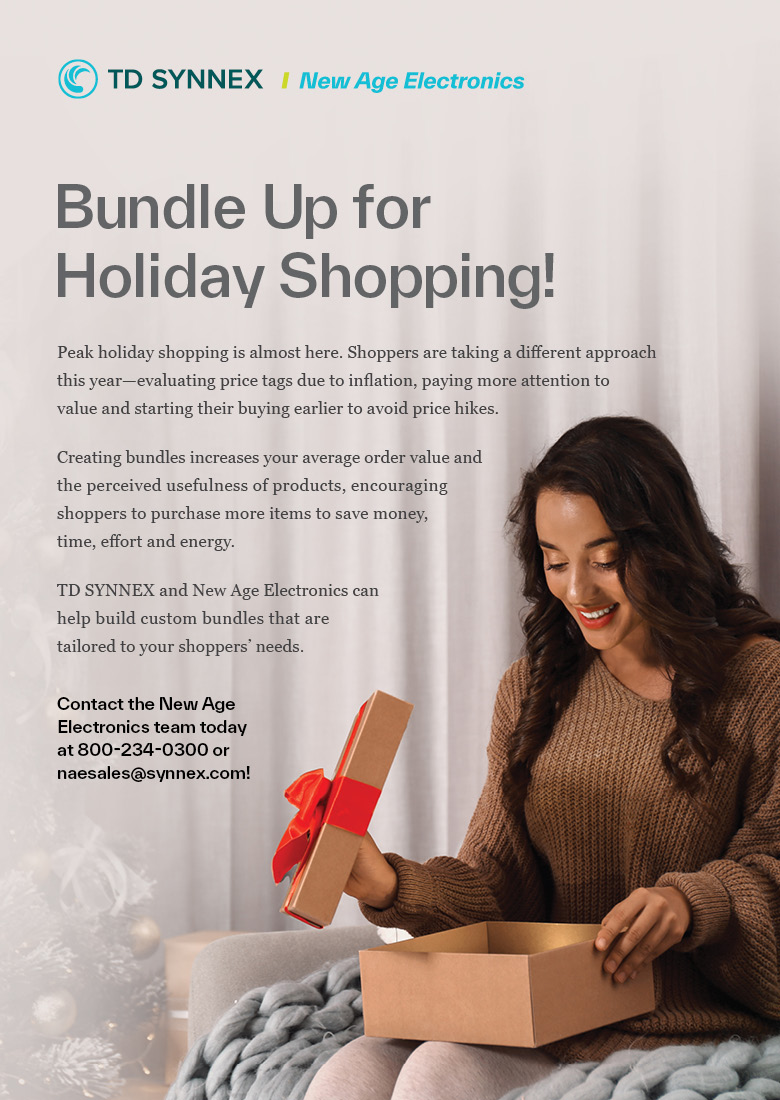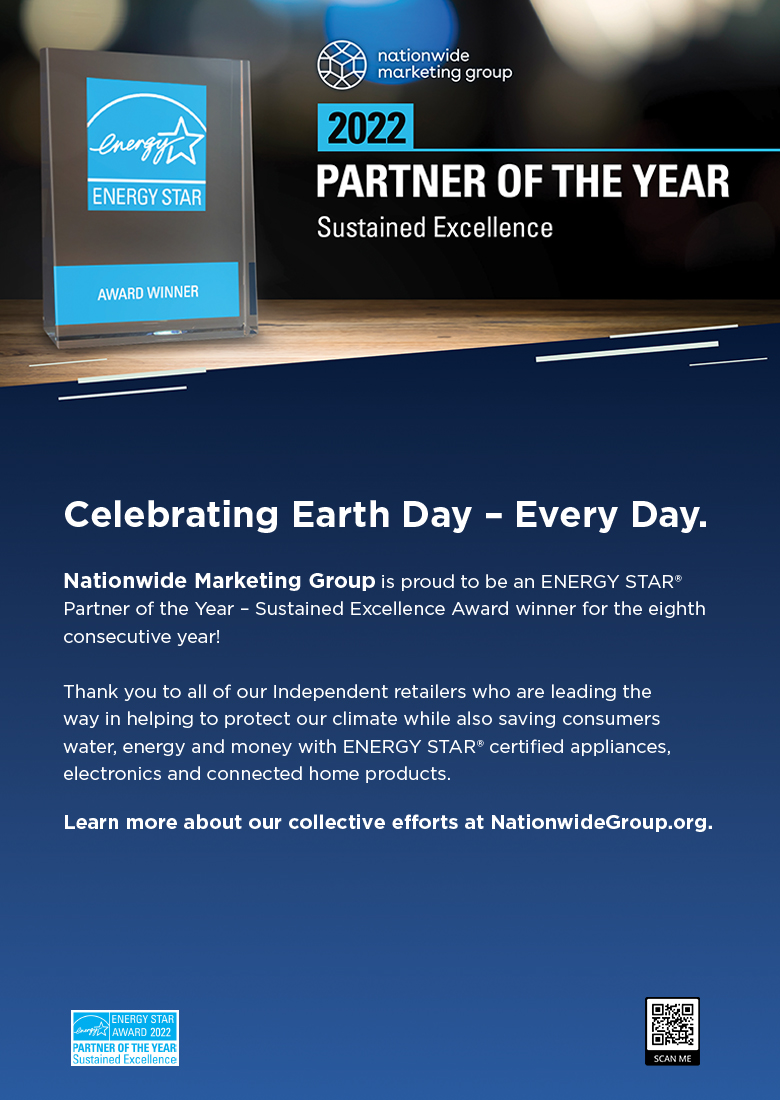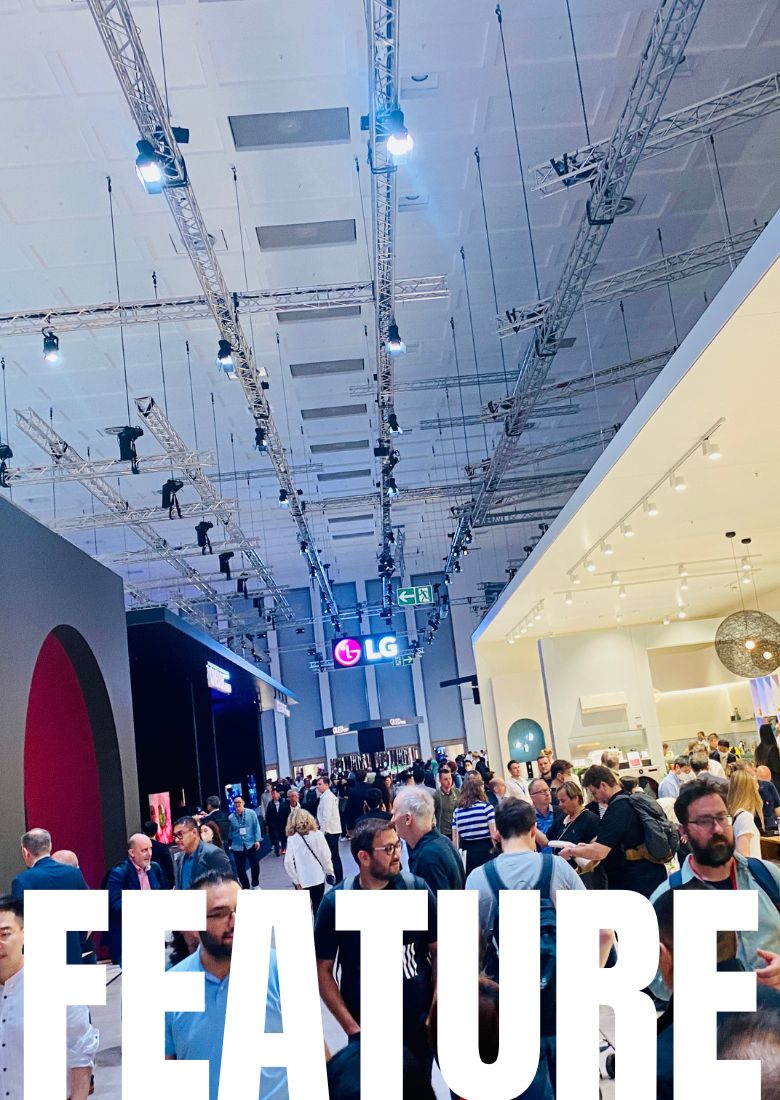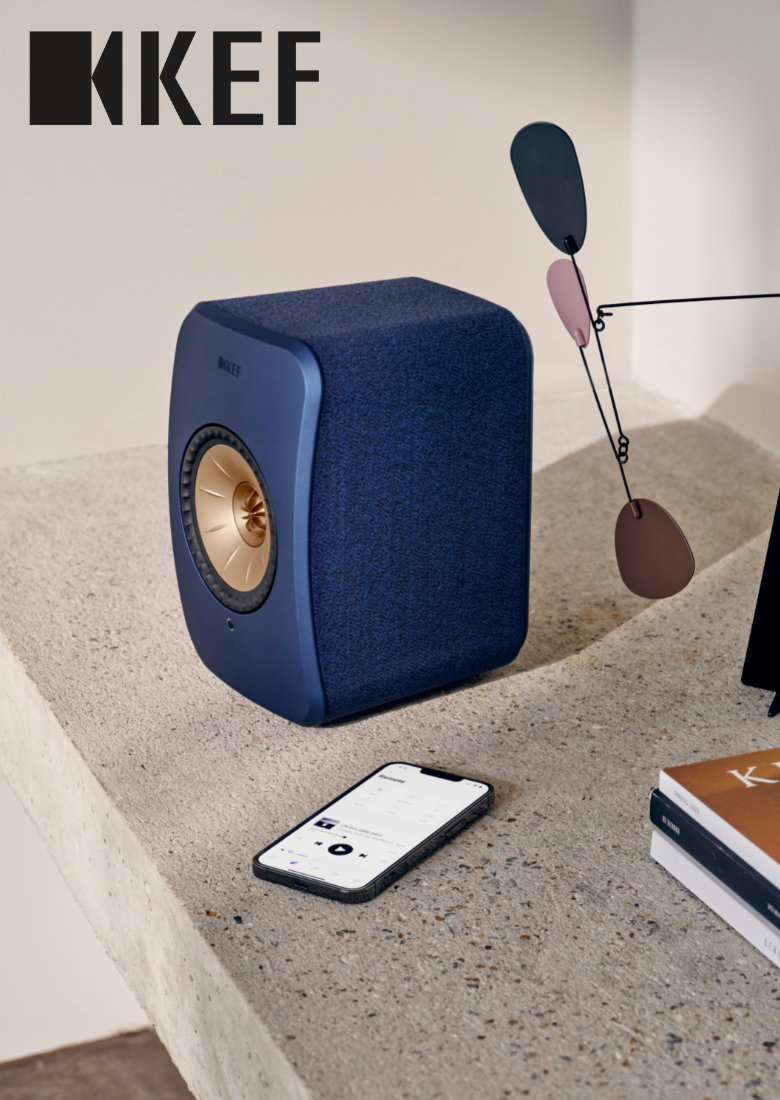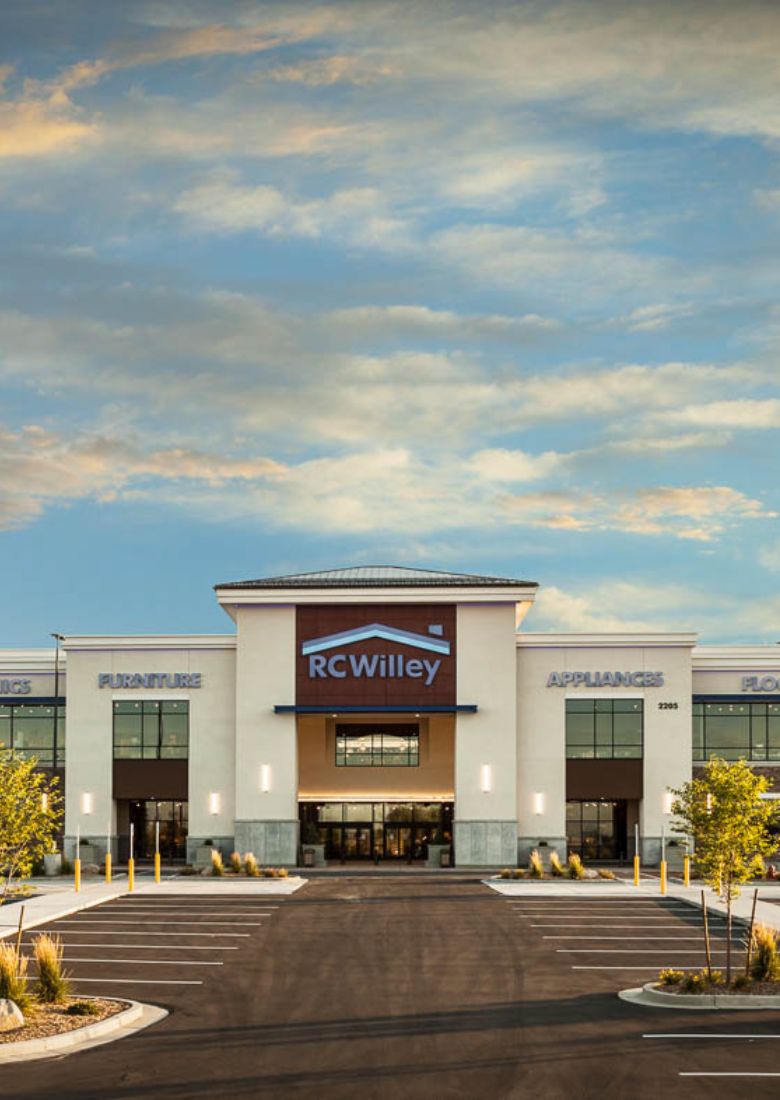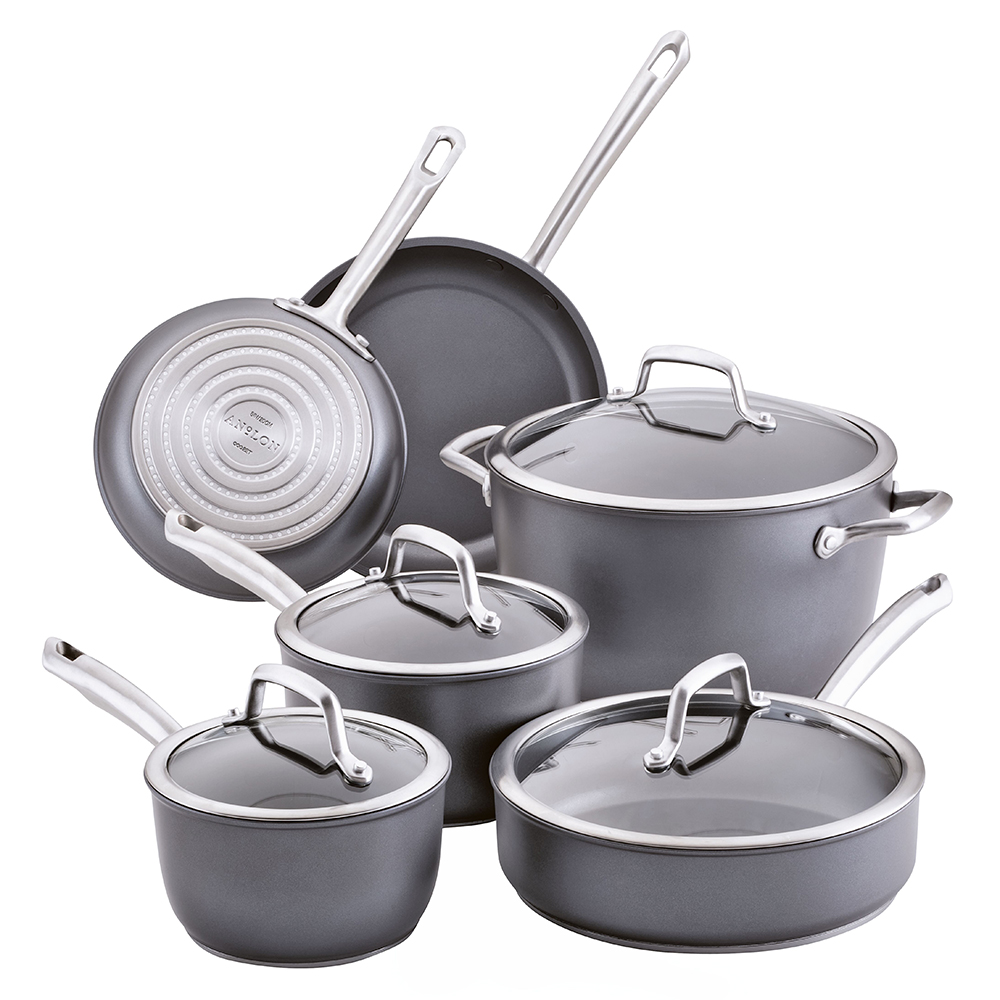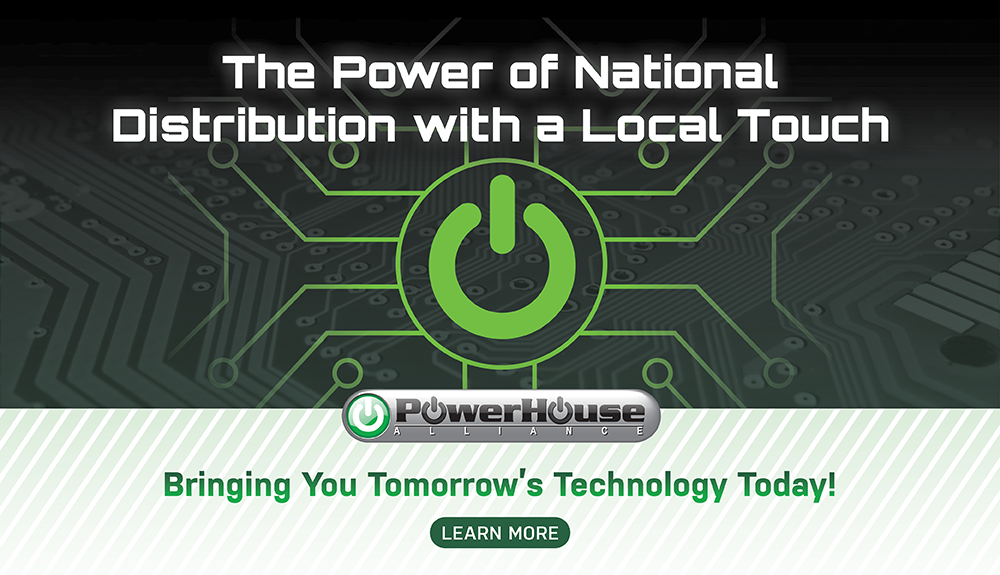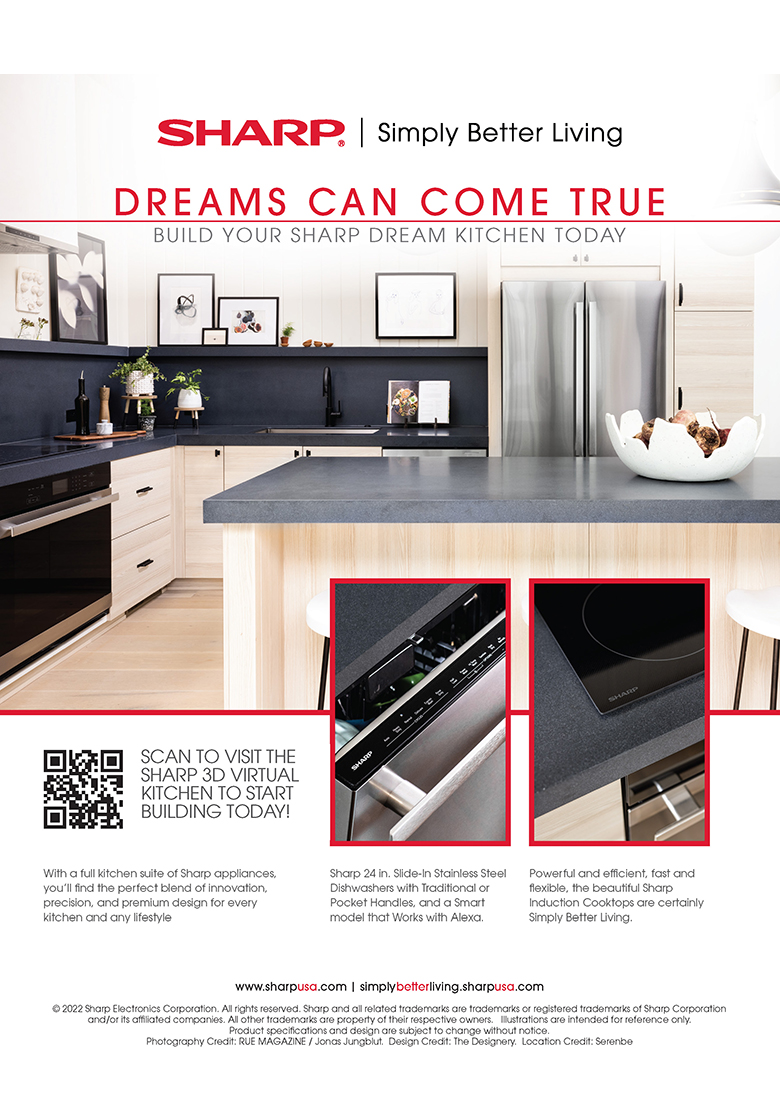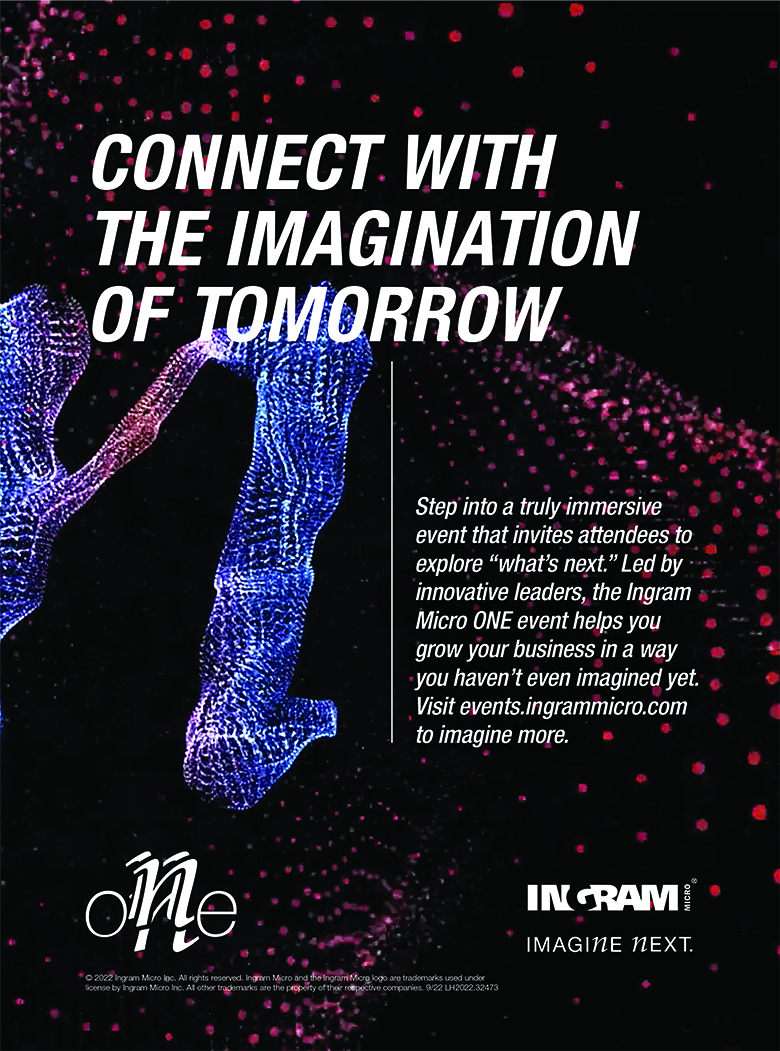In this issue, meet the honorees of the Powerful Women in CE Tech Awards. Plus, learn about the rising figures of the blockchain universe in a cryptocurrency feature, and find out what’s happening in the car tech market today.

Here’s to Our Industry’s
Powerful Women!
“A woman with a voice is by definition a strong woman. But the search to find that voice can be remarkably difficult.”
– Melinda Gates
I like this quote by Melinda Gates. I ask — why in our industry does it need to be difficult for women to find a voice? Can we start to change this? I believe we can and have started to see changes.
The Dealerscope October issue is one of my favorites, as it showcases “Powerful Women in Consumer Technology.” Here we honor the achievements of smart, accomplished women within our industry. This year, our honorees are an amazing group, and I want to personally congratulate each one.
I recently went to the Nationwide PrimeTime event, where they hosted a luncheon for their “Women in Nationwide” members and allies. The presentation was given by John Boyd, vice president of retail business at GE Appliances, a Haier company, as well as Mary Moulton Putman, vice president of marketing & brand at GE, on how to support the industry through mentorship as well as diversity and inclusion.
This was an informative session on how we can support women. I learned a lot and was reminded how great women had been important mentors in my own career. These are the sessions and events our industry needs — not the old, traditional “look at me” events. Congratulations to Nationwide Marketing Group on taking the lead in this initiative.
Our October issue also includes our annual “Retail Excellence” awards. This year we honor four great retailers. They are Audiotronics, Conn’s HomePlus, RC Willey and Wilshire Media Systems. They all have rich histories, and we invite you to please read about them within our pages. We also have coverage on Fall accessories, short-throw projectors, HD audio, digital signage, and more.
Our new contributing editor, Brittany Mier Y Teran, has written a feature on cryptocurrency, a topic that I am very excited to read about. We also feature a Distributor Roundup, with insights compiled by Nancy Klosek, and our Car Electronics Roundtable, handled by Steve Silver. Both provide an outlook on what’s happening now, and what is to come. I also want to call your attention to our look at the category of data in the industry; we kick it off in our October issue feature labeled “Gaming Tech.”
Please note, if you have not been getting our newsletters, I would like to know. We changed our software, so I want to make sure the industry’s most important news is hitting your mailbox. Please contact me at tmonteleone@ctlab.media
Best always and have a wonderful Halloween!
Tony Monteleone,
Group Publisher of CT Lab Global Media
A WORD FROM OUR EDITOR IN CHIEF
When Change Is Good

Fall for inspiring stories in this month’s issue
Here in the South, the fall season is synonymous with the long-awaited cooldown in the weather, the busyness of school and business travel and football, of course. While the Dealerscope staff are traveling around the country and globe covering stories on consumer tech, it’s easy to forget that this change in the seasons is just as predictable as ever, and just as welcome — unlike the challenging changes in our supply chain, our businesses and sometimes, throughout the world.
But, like with the changing seasons, we all know that change in our industry can be quite good. Women in the technology industry were largely under-represented up until recent years. My mom is an example of how this happens: as a young engineer back in the 80’s, she found out the less-than-qualified man she was training was being paid more than her. When she spoke up, she was let go. Fortunately, her story ends well, with her finding another company that supported her and even offered her higher education in her 60’s to advance her career. Today, we are seeing more of these happy endings because of the changing industry.
That’s why this month we are proud to present our 2022 Powerful Women in Consumer Tech Honorees, which consists of women who have inspired and encouraged others in the industry. The goal of this award is not only to recognize these individuals, but also to encourage more diversity in the industry and in the workforce in general. Reading through their responses, I was encouraged by how many said their employers and co-workers rallied with them to support their careers, even if they were the only woman there. That’s excellent change!
We have several other inspiring stories in this issue, including our features on the Retail Excellence Award winners and an incredible story from contributor Brittany Mier y Terán on how women are working in the cryptocurrency world. Hear about the successes of distributors and how they’ve reset programs and priorities in sync with dealers’ needs and wants. And in case you missed our Digital IFA post-show issue (you can subscribe online for it still!) check out our coverage of the show and all of its inspiring programming.
Thank you for reading Dealerscope magazine.

Erinn Loucks
Editor in Chief

CE RETAIL TECHNOLOGY
October 2022 CE News

DTC Software Logistics Firms Flourish | Direct-to-consumer (DTC) retail exploded during the pandemic as companies sought to gain access to their customer base without using third-party retailers or intermediaries. However, the logistics of DTC retail are vastly different because instead of shipping products en masse to distribution centers or stores it forces companies to manage the flow of individual goods. To manage these shifting logistics, companies have increasingly turned to supply-chain software technologies, which help to streamline the shipping process and remove points of inefficiency.
U.S. Consumers Struggling with Increasing Credit Card Debt | In the second fiscal quarter of 2022 credit card balances increased by $46 million or roughly 5.5 percent from the year’s first quarter. Moreover, the number of new credit card accounts in the country grew by 13 percent on a year-over-year basis, which is the largest recorded jump in the last 20 years. With the increase in accounts came a $312 billion or 2 percent increase in household debt, as consumers struggle to keep up with the high prices of everyday necessities.


Retailers Turn to Liquidators to Clear Inventory | In 2021 consumers returned nearly 16.6 percent of the products they purchased, accounting for a 6 percent increase from 2020. In total, the returns made up $761 billion in lost sales. This dynamic indicates that the market is currently over-saturated with unwanted consumer goods. As a result, retailers are turning to liquidators to help move inventory -often for pennies on the dollar- and clear shelves for new in-season products.
Target Makes eCommerce More Profitable | Target is improving eCommerce profit margins via an array of sortation centers that leverage a contract carrier force and source products from stores instead of warehouses. At the sortation centers, workers sort products, which have been packaged for delivery in store backrooms, into bundles for delivery to the same town or neighborhood. Target will have nine of these facilities nationwide by the end of January 2023. Nationally, the sortation centers handled a whopping 4.5 million packages in the first quarter of 2022.


Meta Closes the Door on Facebook Live Shopping | Meta has ditched Facebook Live Shopping in favor of merchants focusing more on promoting products via Facebook and Instagram Reels. Users are no longer able to host or schedule live shopping events, create product playlists or tag products in Facebook live videos. In its post detailing the decision, the company said: “As consumers’ viewing behaviors are shifting to short-form video, we are shifting our focus to Reels on Facebook and Instagram.”
Inflation Reduction Lowers Barriers to EV Ownership | In 2021, EV sales totaled 8.6 percent of all new car sales and that number is only expected to increase over the coming years after the Inflation Reduction Act was signed into law earlier this Summer. The new measure features funding for over 500,000 new EV chargers and provides a slew of incentives for customers and manufacturers alike. The target of the new legislature is to promote EV purchases from more low-income consumers.

IFA NEWS
What You Need to Know
from IFA 2022
The international CE trade show is back
and more vibrant than ever
Compiled by Alec Paige

The 2022 IFA convention, where brands, retailers, press and enthusiasts of consumer and home technology come together for the latest developments in the industry, recently took place from Sept. 2-6 in Berlin. This year, a record number of products from world-renowned electronics brands were announced for the first time to the public. IFA takes place throughout over 30 display halls on the Berlin Exhibition Grounds, with focuses on many subindustries in consumer technology such as Home & Entertainment, Audio, Fitness & Digital Health and more. Another large part of IFA is the summits, keynotes and hubs concerning issues that the consumer technology industry faces today.
Though tickets are only available in advance — there are no in-person ticket sales — keynote livestreams are available on IFA Virtual on demand for those who couldn’t attend in person. This includes IFA highlights like the IFA+ Summit, the SHIFT Mobility conference, IFA NEXT Innovation Engine and more. Not only does IFA Virtual serve as a remote viewing service, however, but also as a means to connect trade visitors and exhibitors for networking purposes.
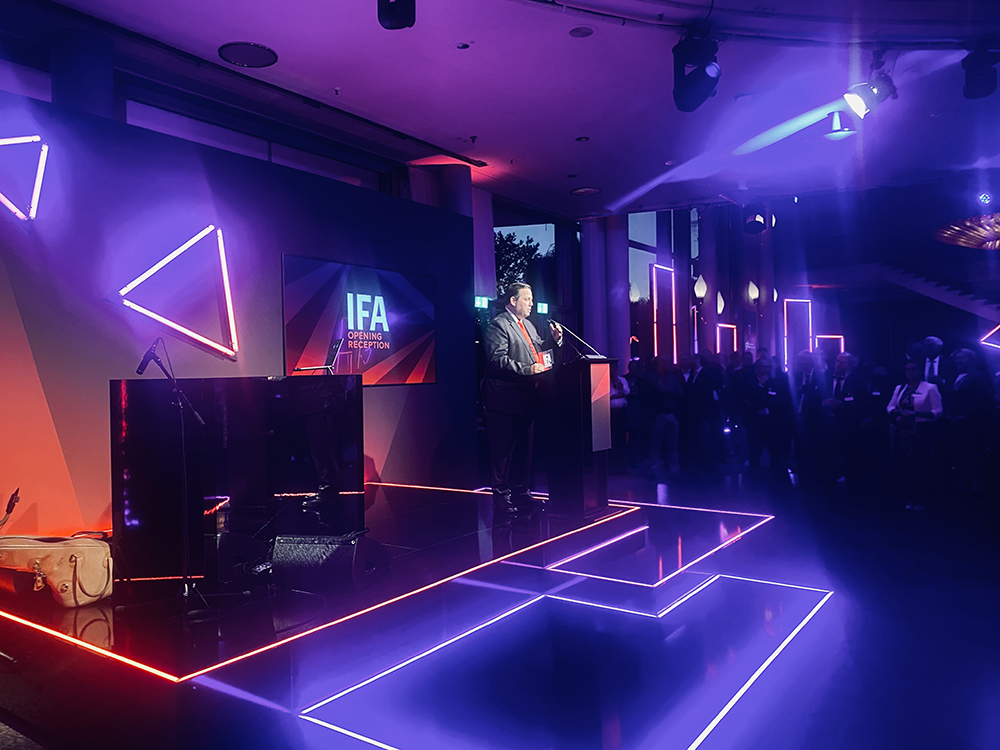
IFA took place from Sept. 2-6 with some events taking place in the days leading up to the convention. There were various highlighted events taking place throughout the week. One of those was the SHIFT Mobility event, which consists of two parts. The first part was a two-day B2B conference made up of high-profile speakers, masterclasses and more. The second part is a six-day “Exhibition & Experience” area, where new products were showcased and demonstrated. The IFA website states that SHIFT Mobility, “aims to be THE conference on trends at the interface of mobility, sustainability and technology.” The key topics of this conference range from sustainable mobility and circular economy to renewable energy.
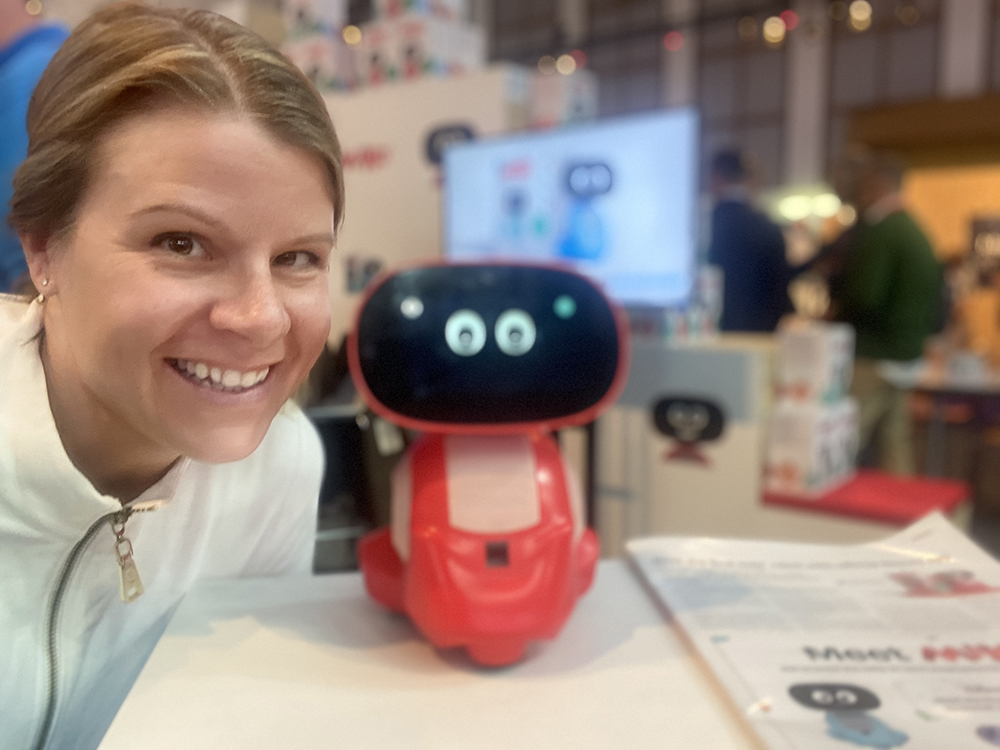
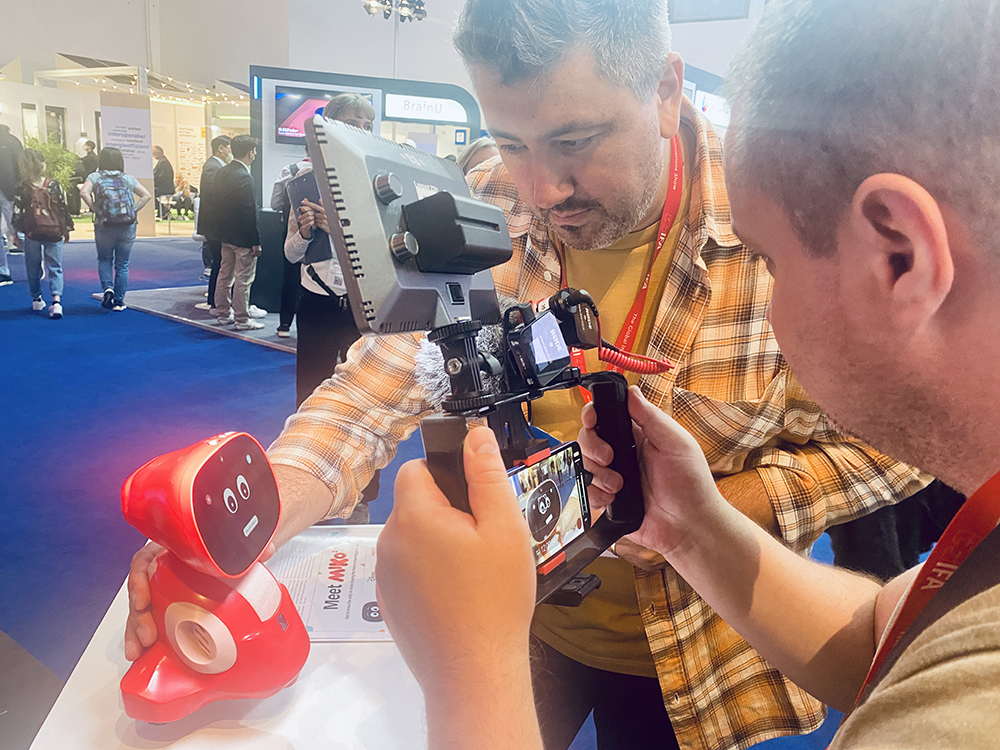
Meanwhile the IFA+ Summit focuses on the discussion of the future of globalization and trade concerning the consumer and home technology industry. Specifically, the Summit touched on the uncertain future of globalization against the backdrop of many issues that both industry and world presently face; climate change, social issues, supply chains and the war in Ukraine are a few of those issues. The IFA+ Summit gathered guest speakers and panels of experts to discuss these problems, among them Prof. Marcel Fratzcher, Ph.D., president of DIW Berlin, Prof. Yanis Varoufakis, an economist and former finance minister of Greece, Dutch philosopher Peter Sloterdijk and Jürgen Trittin, former minister of the environment and member of the German Bundestag.
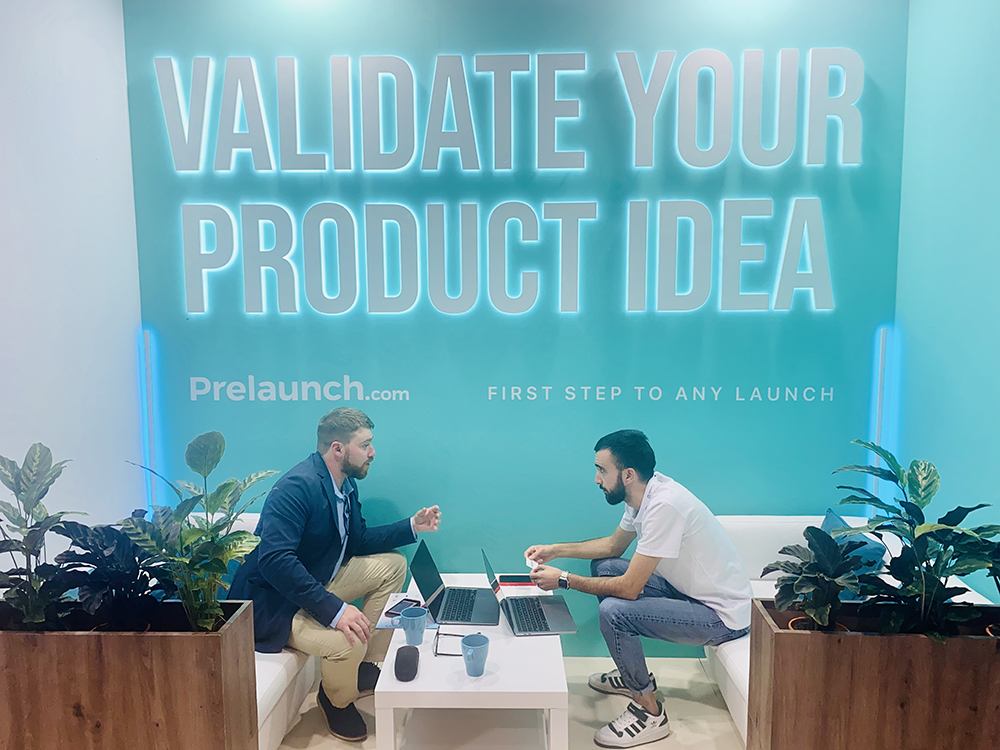
One of the other highlights that must be mentioned is IFA NEXT, the show’s forward-looking and sustainability-focused innovation hub that took place in Hall 20. Startups, experts, associations, institutes and grounds across the consumer electronics, home appliance and smart home industries presented strategies and innovations for a more sustainable future. There was a focus in carbon-neutral and resource-friendly methods of production as well as product repairability and recycling. Just like the IFA+ Summit, IFA NEXT featured lectures and panels but will also include pitches from startups. On Monday, Sept. 5, any attending IFA were able to visit the IFA NEXT Innovation Engine stage, where speakers in science, politics and the electronics industry shared their thoughts on the future. Also featured at IFA NEXT were solutions and presentations on interconnected home devices highlighting the social, healthy, sustainable and efficient aspects of the growing industry.
But those are just a few of the highlights and events from the show. There were IFA keynotes on Sept. 2-3, the Berlin Photo Week event from Sept. 2-4, daily programs throughout the week and the IFA Global Markets events from Sept. 4-6. There was also the Berlin Reception, which is designed as a sort of meetup event combining music, media and tech on Sept. 5.
Every year the fall season is a busy time for the consumer and home technology industry, and IFA is one of the largest contributors to breaking news and stunning reveals of new products. Whether you were able to attend in person this year or not, IFA will have reaching implications on the industry.
MOBILITY
It’s All About the Journey
Experts weigh in on what’s happening
in the car tech market today
By Steven Silver

When it comes to car technology in 2022, there’s a lot going on.
On the electric vehicle front, the federal government has moved to encourage electric vehicle adoption, including funding for $7.5 billion worth of EV charging stations.
In August, California finalized a rule that will phase out sales of gas-powered cars in the state by 2035 — the first time any government in the world has issued such a mandate, although the governor of Washington State announced his intention to follow suit just days later. Most of the major car manufacturers are in some phase of transitioning to electric cars, seeking to cut into Tesla’s dominance of the market.
Meanwhile, the auto industry — and Silicon Valley along with it — is still trying to crack self-driving cars. They’re not nearly as ubiquitous as some predicted they would be by now, as Apple had aimed to launch by 2020, and Tesla has made numerous promises over the years about timing. But the tech does have some practical applications — especially when it comes to deliveries — with everyone from Walmart to Domino’s Pizza on board. There’s also innovation going on when it comes to software, with a new version of Apple’s CarPlay expected this fall.
Hanging over all of that are gas prices, which hit record highs earlier this year, and have served to keep less motorists in the car than usual. Average gas prices have continued to drop to below the $4-per-gallon market by mid-August, but they remain higher than is typically the case.
As for the auto aftermarket picture, NPD Group reported back in March that the average selling prices for the overall auto aftermarket jumped 14 percent in 2021, with prices for consumer replacement tires, specifically, increased 13 percent.
“The tire industry, like many others, is experiencing the effects of a shift in overall consumer behavior as it relates to pricing and demand,” Nathan Shipley, automotive industry analyst for NPD, said in the spring announcement. “Driving behavior has changed over the past two years, but the needs are still there. Consumers are currently focused on getting what they want, while they can, with what is available to them at retail stores.”
What are the major stories when it comes to car tech this year? Dealerscope asked some industry experts, including Thomas Healey, the COO of Seattle-based CarToys; Han Farouk, Operations-Management of Car Stereo Warehouse in Charlotte; and Bobby Gummadi, the Dover store manager of the Mid-Atlantic-based Sound of Tri-State.

Dealerscope: What technology trends are you seeing in cars today?
Healey: “There are greatly improved driver’s safety/self-driving capabilities through the integration of sensors and cameras with vehicle controls and displays. Much more information is now available to the driver visually through vivid screens, providing clear, precise information as opposed to analog gauges. Car Play/Android Auto software has literally brought everything available on your mobile phone into your vehicle. The latest version of Car Play to be made available with iOS16 this fall will expand on this information to include speedometer and tachometer, along with a host of onboard diagnostic information chosen to be displayed by the driver. The quality of car entertainment has also greatly improved. From bigger, better screens to louder, clearer and more immersive audio, this trend will certainly continue culminating in highly immersive environments as vehicles become capable of self-driving.”
Farouk: “The technology trends tend to shift every one to three years for different fads in the market. Currently the most popular trend is integrating Apple CarPlay and Android Auto in vehicles today. In the process, an additional must-have is a backup camera. The second trend starting to pick up are dash cams. People want to protect themselves from those drivers that don’t follow safety protocols and defensive driving. Part of this trend comes down to the markets’ need for convenience, quick and simple integration and safety from the unknown. LED light kits are a huge trend for turning heads. From underbody, to wheel lights, the rocklights, interior million color lighting, headlights, taillights, dome lights, accent lights and door lights, any light needs a custom touch to it to stand out. You can never have enough lights.”
Gummadi: “We’re seeing wireless integration, including Apple Carplay, Android Auto, Bluetooth streaming and wireless charging.”

Dealerscope: Where is networking going next in cars?
Healey: “Vehicle networks – CAN bus systems – have grown rapidly in sophistication the past few years with the advent of EVs, which are requiring advanced charging systems and the integration of numerous sensors into driver’s safety/self-driving capabilities. Further, the development of telematics capabilities have expanded the ability of CAN bus systems to communicate vehicle performance information externally. Future networks will continue to expand in processing power as well as the ability to integrate with external communications from technologies such as Wi-Fi, Bluetooth, Ethernet and ZigBee (IoT devices), allowing for a more comprehensive integration of the vehicle with its surroundings. As in-dash displays further integrate with the vehicle network, more information can be made available to both vehicle occupants as well as those outside the vehicle through telematics. Essentially, vehicles are becoming more c’onnected’ every day.”
Farouk: “Safety must be the first; therefore, technology evolution has no limits, from Aux/USB to Bluetooth, from Bluetooth to Apple Car play. The industry will always be integrating our day-to-day life into our cars schematics, which leaves the networking around the corner. Already Yelp has made its way into the industry via Weblink/ mirror link app.”
Gummadi: “I think it will go in the same direction that it’s already going as far as a seamless and wireless system, just a better version in the future.”
Dealerscope: What new tech is currently being developed for self-driving cars, and what challenges still remain?
Healey: “Tesla is clearly leading the way here, as their vehicles are nearly already capable of self-driving. Every EV maker is jumping into this space along with software companies such as Apple and Google along with chip companies such as Nvidia. The overwhelming challenge is safety. Road infrastructure – lane boundaries, traffic signs, crosswalks and numerous other features will need to provide better cues and more vehicles will need to be equipped with vehicle-to-vehicle communications capability before self-driving is a reality. As CAN bus processing power increases and AI technology advances, self-driving cars are an inevitability. The final hurdle will be overwhelming evidence that such vehicles are safe.”
Farouk: “Our specialty revolves around the 12V aftermarket industry. The newer cars have become more difficult to work on and integrate due to new features of the OEM components that can come off the dealers lot. For [example], ANC for Bluetooth creates feedback in subwoofers, which can lead to new parts.”
Gummadi: “Fully autonomous driving, and ride sharing with driverless cars. For example, Waymo is getting larger on the West Coast and could spread over the U.S. very quickly. As far as challenges, I think the infrastructure that’s out for wireless charging isn’t enough to keep up with the demand that we’re going to be seeing in the future.”
Dealerscope: What is your favorite car electronics product today?
Healey: “As a music lover my favorite products are the digital signal processing devices that allow a vehicle to be precisely tuned to its unique acoustic environment. Along with high quality aftermarket speakers, amps and subs one can experience a concert hall level sound as a soundtrack to the world whizzing by as you drive. This long-time customer value proposition is greatly enhanced by hi-res music, DSP and the much-improved audio components available today. It will be even more enhanced as advanced digital audio technologies like Dolby Atmos can be enjoyed in cars.”
Farouk: “Apple CarPlay, blind spot detection and radar detectors helps with day-to-day practicality of life.
Gummadi: “Personally, I think wireless Carplay/Android Auto is the most useful product that we offer.”
Dealerscope: Where do you think car tech is going next?
Healey: “In general, vehicle onboard networks are gaining speed, processing power and the ability to sense and communicate with their external environment. These enhanced capabilities will inevitably lead to self-driving cars; in the meantime, they will provide an increasing immersive, information rich and connected environment for drivers and their passengers.”
Farouk: “Car tech advancements are above and beyond our imagination.”
Gummadi: “With prices of new vehicles going up, I think the demand for aftermarket products that integrate modern features in older vehicles will grow.”
2022 RETAIL EXCELLENCE AWARD
Dealerscope is honored to present the inspiring stories of the 2022 Retail Excellence Award honorees. This award recognizes a select few independent retailers who demonstrated exceptional business performance and are leaders among their peers. Our spotlighted honorees have navigated significant challenges over the years and have shown incredible endurance and innovation in spite of these tumultuous times. They have shared with us here some of their secrets to success, from ensuring their customer service is top notch to investing in employee knowledge and development.

With a primary, highly visible retail operation in Roanoke, Va., and an additional location in Blacksburg, Va., Audiotronics, Inc. has cemented its position as a destination store for seekers of CE retail and custom services in its region.
“As our name implies, we began life in the go-go hi-fi golden age in the 1970s,” said Alan Guyes, co-owner and A/V buyer, who has been with the enterprise, which is gearing up to celebrate its 50th anniversary in 2025, for 42 years.
Guyes had been on a career trajectory heading into law practice but opted instead in 1980 to enter the A/V retailing arena by partnering with fellow college undergraduate John Ferguson, who has since retired; he is currently a partner with Audiotronics’ president and co-owner, Matt Hartberger. “It’s been quite a fascinating and totally unexpected ride — video, security, electrical, automation, lighting, shades, streaming and much, much more — the changes to our industry have been profound,” he said.
The pandemic’s influence on business, Guyes added, “sped up trends that were already in play,” — one being consumers’ proclivity for buying larger-ticket items from the Internet instead of visiting stores. “I don’t consider this to be a negative, as it has forced those that remain in the physical space to up their game,” he says. The roller coaster nature of COVID, too, had its effect — as it did for all retailers. “We saw business drop precipitously and there was a concern we were looking at retail Armageddon. A month or two later, we were struggling to keep up with demand.” He noteed, however, that “we were lucky to be an industry that was very much needed.” Deemed an essential business in Virginia, Audiotronics remained open to service customers during the pandemic, while it “pruned as well as expanded our areas of concentration to retain relevancy to our customers.”
Audiotronics counts the lighting, shading and electrical categories among its wide array of offerings. Having added full-time electricians to its staff, Guyes said, “gives us the opportunity to work at a much earlier stage with the customer and the home builder. If we do our job correctly, we can instill confidence and then talk about other goods/services we can bring to the project.” The impetus for moving into electrical came from Hartberger, who is also an electrician and whose father is a master electrician.
Reinforcing Audiotronics’ online presence has been its creation of online videos, product reviews and product-use tutorials, which, with a refresh of the company website, is a “work-in-progress, long-term project,” Guyes said. Online chat has also been adopted as an invaluable tool in its customer communications arsenal. And while the company had always set its store by solely tasking its sales staff with end-to-end handling of customer meetings, proposal creation, project design and installation, that is changing, he said. “Frankly, this served us well for many years. With increasing workloads and project complexity, we are following the lead of many in our industry and creating job roles to assign different parts of the job to different staff members. It’s difficult to change the culture of 45-plus years, but it needs to be and is being done.”
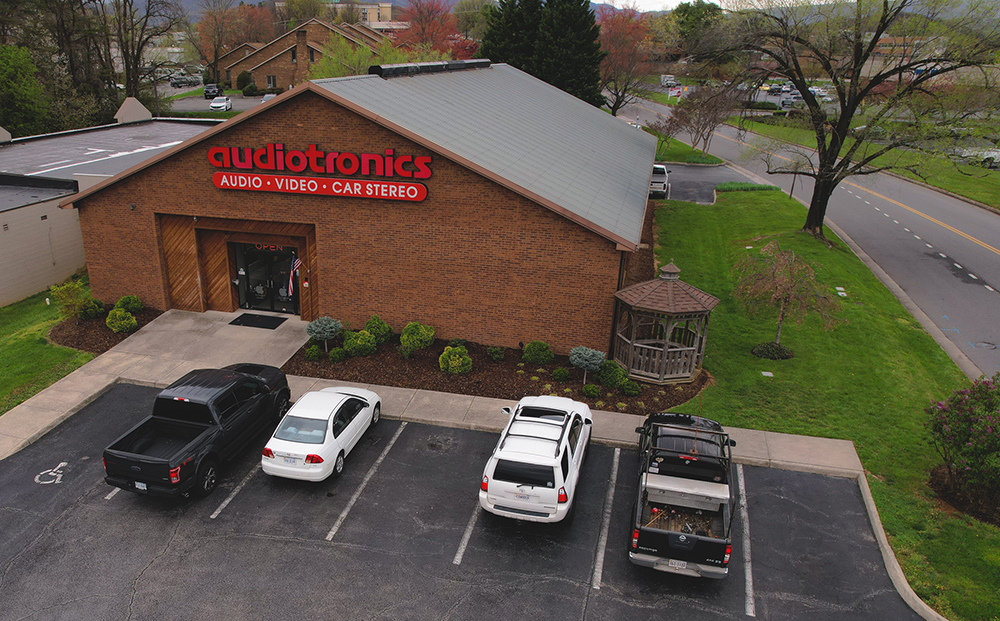

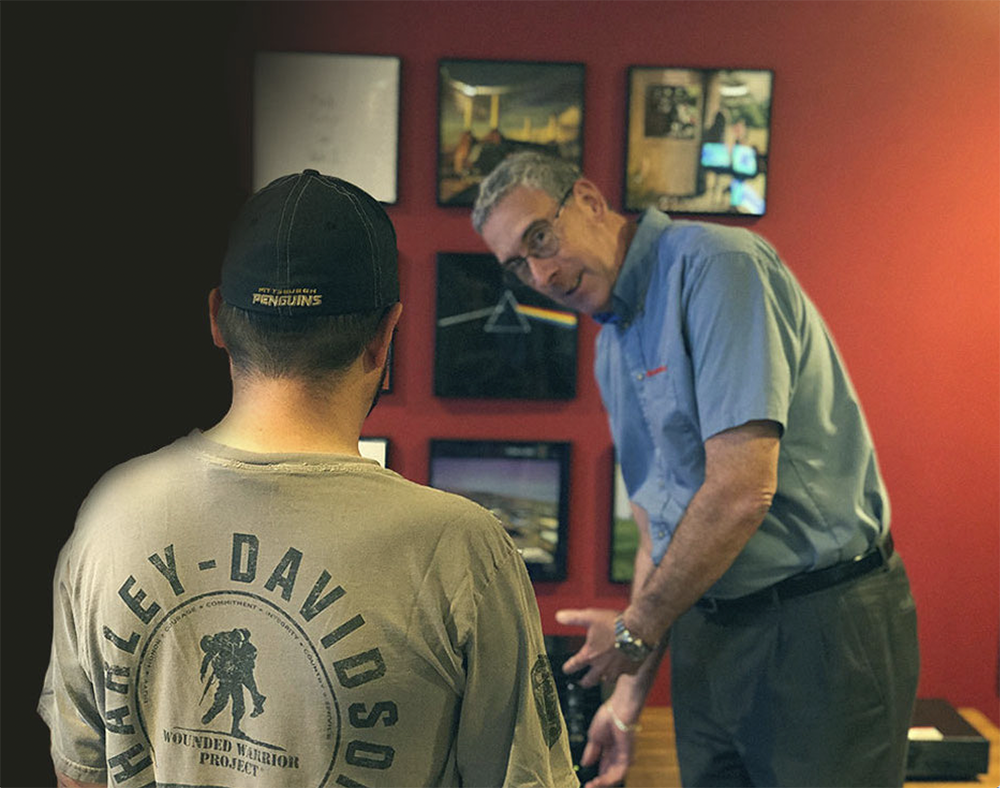
High-End Audio, 12-Volt & Service
Specialty retailing’s bread-and-butter categories — high-end audio and mobile electronics — endure as important product areas for Audiotronics, with upper mid-fi audio goods experiencing “strong demand at retail” and 12-volt remaining “a significant driver of our business,” he said.
“Clearly, many customers seeking [higher-end audio] want to experience them in a retail environment versus ordering boxes over the Internet.” As for 12-volt, he continued, “we remain extremely busy, be it a car radio replacement, car radio repair or integration of newer technology to an older vehicle… I chuckle, as the death notice for the 12-volt industry has been announced too many times for me to count, but our industry, much like the home A/V industry, continues to innovate to remain relevant. We’ve got great car installers; they’re really quite talented computer technicians.”
The company has also bolstered its service side — a crucial component of its ongoing after-sale relationships with its customers. He recalls “going to CES eight or 10 years ago when the theme was ‘own the network, own the home.’” It was plastered on all the buses and signage and halls. It kind of makes me think of the dog that caught the car. Now what happens? When the Internet or the phones don’t work, you’re the face to the consumer. They don’t have a contact in the electrical or Internet company; they know you. So you pretty much take ownership of the entire project. It’s a problem, but an opportunity, too.
“The need for service is always going to be there,” Guyes added. “If anything, it will be beefed up, because systems are becoming more complex and there are more opportunities for them to fail. You need a process in place. Systems lock up, and if you don’t make service top, then you won’t stay in business.”
It’s clear that Audiotronics, for its part, has found a winning formula, as it continues on with a well-established presence and reputation anchored by skill sets that are enduring and relevant — and that have made it the success that it is.
2022 RETAIL EXCELLENCE AWARD

This past year has had its ups and downs for retailers across the globe, with both product supply and consumer demand issues, and for electronics and furniture retailer RC Willey it’s been no different. RC Willey, which is celebrating its 90th year of business this year, offers plenty of high-end electronics, with options in 4K and 8K televisions, home audio setups, gaming options, smart home products and much more. But the retailer also extends into home furnishings and appliances, creating an expansive and multi-faceted storefront where customers can test out plenty of demo products around the store. With fourteen locations across Utah, California, Nevada and Idaho, the company has a solid physical location spread across the western United States, and of course also offers online shopping options.
But just like the rest of the industry, RC Willey struggled through the complications brought about by the COVID-19 pandemic and has had to overcome a number of challenges in the hectic and confused post-vaccine retail world. Last year brought record-breaking sales to the company, but general inflation and shipping costs have added to other issues, leading to a more confused, inconsistent and uncertain purchasing phase for consumers in 2022. And according to Todd Booth, vice president of merchandising for RC Willey, there’s been an adjustment period in advertising and sales going from 2021 to 2022 for the company, demonstrating how much difference a single year can make in retail.
“This last year has been amazing and challenging at the same time. We had record sales in 2021 but in 2022 retail patterns have not been too consistent due to shipping costs and fuel prices, which have inflated the price of goods,” Booth said about the struggles RC Willey has faced this year. He went on to partially attribute COVID-era government assistance money to a purchasing boom in 2021 that is hard to make up for in 2022. RC Willey has had to make a number of adaptations to changes this year, and one of those changes was in its messaging, with Booth saying, “we have had to adjust our advertising to focus more on helping customers solve their problems with our products and services instead of price and item ads.”

Concerning RC Willey’s partnerships through this hectic time, Booth said, “In the last year, our relationships with vendors have been more important than ever.” The uncertain time has solidified and strengthened business bonds between RC Willey and its retailers, and it has even shifted to including its vendors in its advertising. In email newsletters, RC Willey has begun to include highlights of its top vendors, discussing the companies’ histories as well as products and product quality. And it seems that this approach has been very successful. “The open rate on these emails have been record breaking,” Booth said about this unique and relationship-driven approach to marketing. “We learned that there is more than price and item advertising.”
Throughout Booth’s responses, it became evident that the customer experience is heavily valued at RC Willey. The retailer strongly focuses on customer service, educating customers on the best electronics available and creating as hassle-free of a shopping and installation experience as it possibly can.
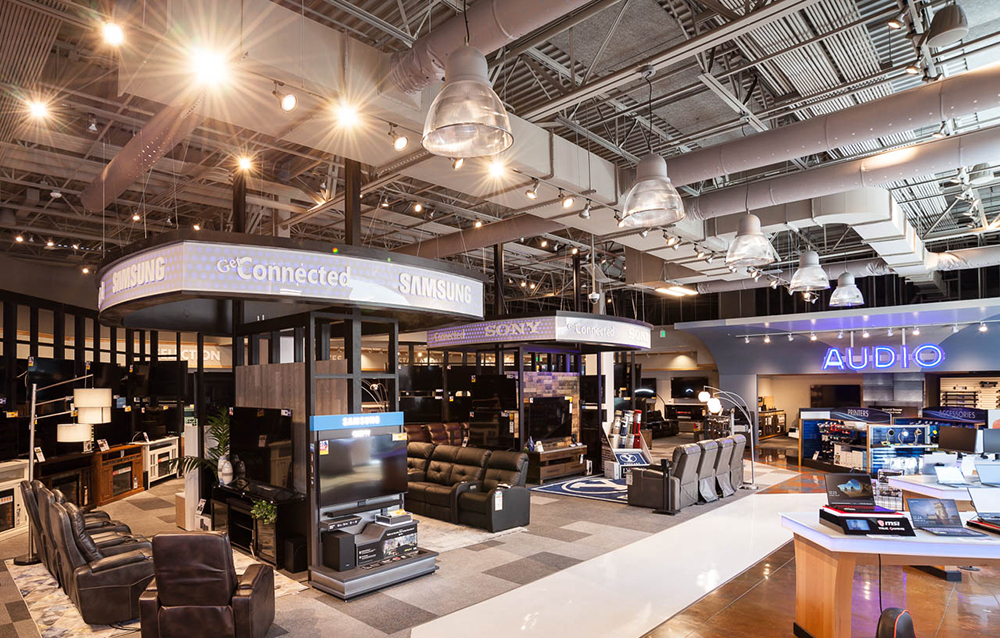
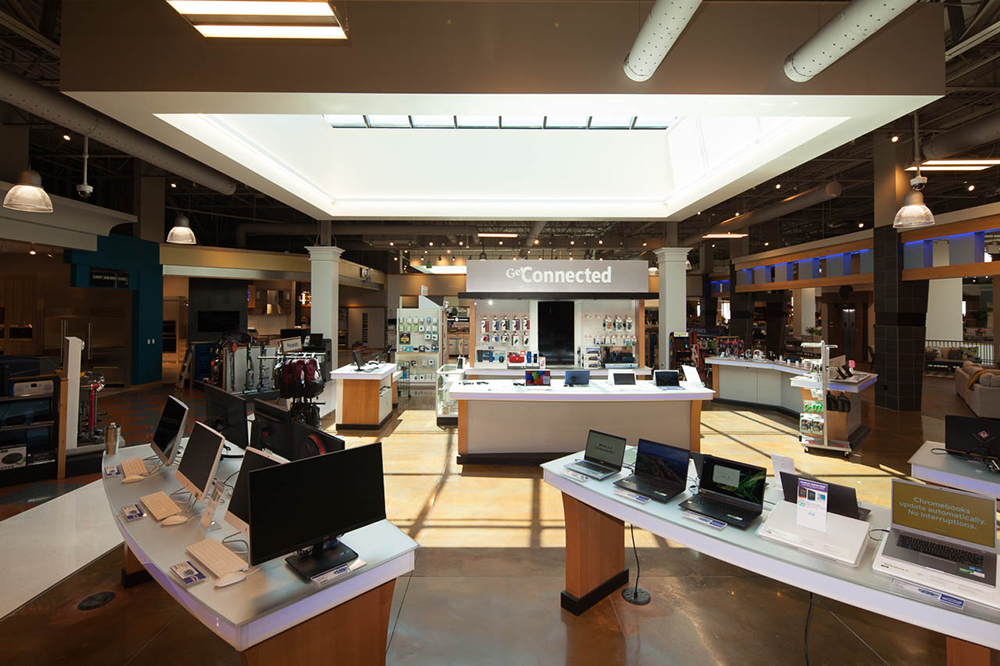
Concerning RC Willey’s partnerships through this hectic time, Booth said, “In the last year, our relationships with vendors have been more important than ever.” The uncertain time has solidified and strengthened business bonds between RC Willey and its retailers, and it has even shifted to including its vendors in its advertising. In email newsletters, RC Willey has begun to include highlights of its top vendors, discussing the companies’ histories as well as products and product quality. And it seems that this approach has been very successful. “The open rate on these emails have been record breaking,” Booth said about this unique and relationship-driven approach to marketing. “We learned that there is more than price and item advertising.”
Throughout Booth’s responses, it became evident that the customer experience is heavily valued at RC Willey. The retailer strongly focuses on customer service, educating customers on the best electronics available and creating as hassle-free of a shopping and installation experience as it possibly can.
“Good customer service can really make you stand out these days and we have focused on improving that experience for our customers,” Booth said. RC Willey has boosted its demo focus in recent months as well, upgrading demos to better educate customers on products before they choose to invest. Displays have been refreshed too, and there are plans to host more in-store events to boost store traffic and create further opportunities for customer education. He credits his team with much of the retailer’s success on the customer relations and education front, saying, “We are lucky that we have a strong sales force that knows how to add on the right products to the sale and make the customer satisfied with their purchase. I am fortunate to work with a great leadership and buying team who really care about our customers and the store experience. It takes a lot of people to keep this company going.”
Presented with a myriad of issues in 2022’s tumultuous and uncertain retail world, RC Willey had a number of adaptations that needed to be made in order to succeed. Under solid leadership and with a dedicated team, the retailer has made those changes and more to stand out in the competitive retail space. But if the last few years have shown us anything, it’s that we are now in an ever-changing world, though RC Willey is ready to adapt.
“RC Willey is committed to improving our services and adapting to any changes that may come around,” said Booth. He went on to hammer home that the customer experience will always be the most important aspect of the business. “Retail will stay strong for the companies that will take care of their customers from start to finish.”
2022 RETAIL EXCELLENCE AWARD

Mike McMaster, owner and president of Westlake Village, Calif.’s Wilshire Media Systems, plies his consumer technology trade at a level of success that is anchored in an ability to adjust his business model adroitly to keep in tune with shifting market conditions.
He is the steward of a company he took the helm of in 2014, but that was founded in L.A. in 1954 as Wilshire TV & Radio. Wilshire entered the custom realm in 1997 and moved out of its facility in Thousand Oaks, Calif., in 2018 to a 5,000-sq.-ft. space in a high-visibility commercial building, becoming a destination/by-appointment business that also entertains walk-ins.
“I still believe in demonstrating technology,” he said, “so we made a significant investment in our latest space — it’s a beautiful showroom,” with categories showcased including audio, video, control, cameras, networking, lighting and shades. There are three stereo rooms of audio and three theater setups within a room that’s primed for demo. A good selection of TV models is on display, and there is a studio in the back that is “like a 20-by-20-foot trade show booth where we show displays and technologies.” He says that when clients see it, they frequently express relief at not having to go to big-box wholesalers and deal with dozens of TVs on shelves. Besides their expertise in CE, Wilshire personnel are also highly trained in presenting energy management and lighting fixture solutions.
McMaster said that Wilshire is “80 to 90 percent focused on our top vendors. Focus is really important in these times with vendors, so you can be really important to them.” He offers clients good–better–best choices within a vendor brand, but “we won’t give them three vendors and nine choices,” to sidestep introducing confusion into the process.
Wilshire subscribes to a policy of customer qualification “up front, after we understand what their goals are — with the products in the back. You see maybe three TVs in little vignettes. It’s woven in; it’s not in-your-face. At our location, the choices are presented; you don’t walk in and see a wall of speakers or TVs, which can be paralyzing for a lot of people.”
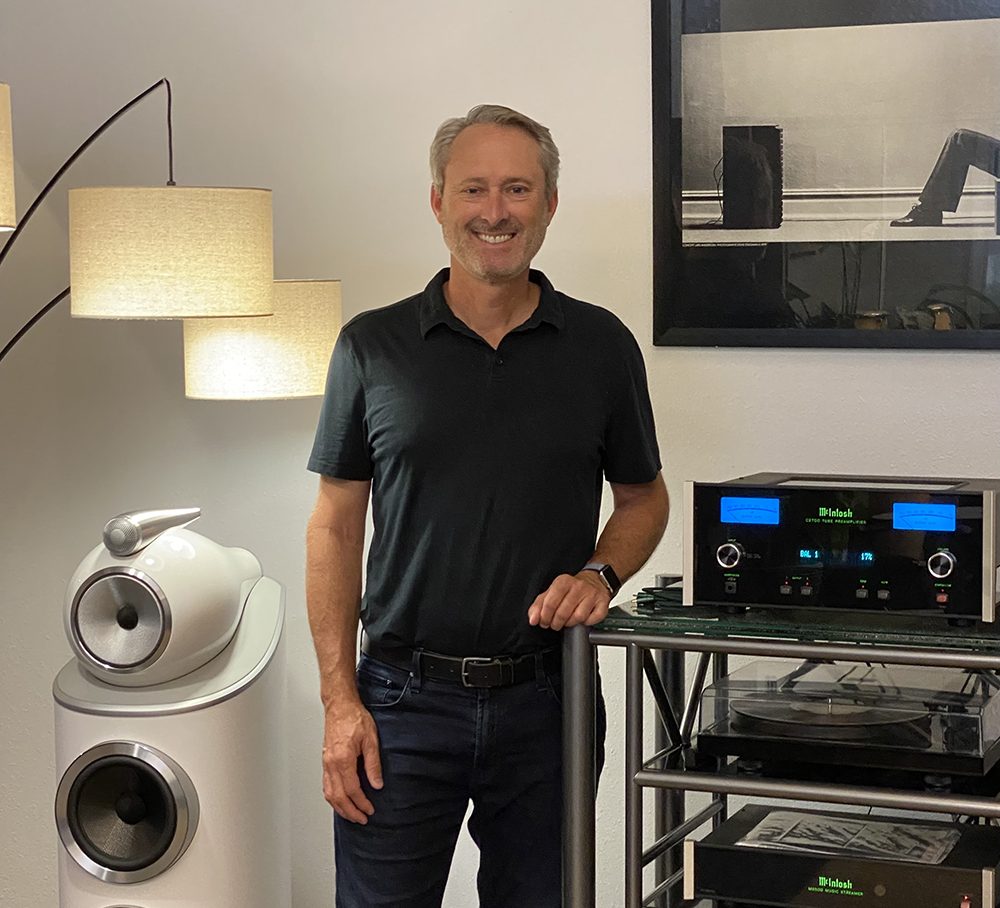


Prioritizing Customer Interaction
McMaster emphasizes his deep investment in staff training on both the installation and sales fronts. Staff members are instructed on customer interaction and the overall workflow. It is a stepped process that he has dubbed ‘crescendo.’
“When we hand over a system, we tell the customer, ‘Here’s how to use it, here’s the training on it, here’s how to contact us for support;’ we give them a gift and thank them for their business. Especially on bigger systems, training them on using the system properly is the proper way to end a job,” he said.
Some other enhancements that have served to fill the bill for a completely satisfying customer experience have included a partnership begun three years ago with a company that allows him to use chat at the front end of the client’s interaction with his website, and also the addition of the services of a 24/7 after-sale support company.
He further cited his showroom setup as a “differentiator” — a way to effectively present what can seem like complex technologies in a palatable, inviting way. “The consumer wants simple, they want easy, and they also want everything — which doesn’t always go with simple. So we navigate those waters. We’ve seen people with a bad taste in their mouth for technology because it’s confusing. But with what control companies offer, what’s great about it, I say to them, is that I can get it all down to one button.
“We’re saying, ‘It’s your money, and we want you to have a choice about what you value. We just want to let you know what’s possible.’ That’s very empowering for a lot of clients.”
The company uses targeted methods of raising its profile among customers who would be a natural fit for the white-glove services Wilshire offers. These include attendance at networking occasions where affluent clients congregate – namely, at charitable events or other gatherings attracting that demographic. “That has been good for us,” McMaster said.
But getting in front of potential clients of all stripes, not merely the well-heeled, in a pro-active manner is a prime directive at Wilshire.
“My belief is that as long as consumers have confusion about technology, we have a business. I believe that that is a sustainable model — educating clients in how to navigate technology and make informed decisions on what’s available. You talk to them, and lead with information. Whatever technologies you choose to carry, know them well, give people options and explain in layman’s terms why things cost what they do and why certain products are better than others. It’s about helping guide people to choices.”
APPLIANCES
Induction is Hot,
Gas is Not
American kitchens are changing as consumers appreciate the benefits of induction technology – and municipalities look to eliminate natural gas
By John R. Quain
It’s not just cars that are going electric. Cooking is running out of gas, too. Natural gas.
Consumers are learning that gas stoves are a significant source of indoor pollution, for example, and so they are becoming more receptive to electric induction cooktops, which are safer, more efficient, more convenient and easier to use.
“The transition to induction cooking has been gaining momentum as consumers have become increasingly aware and knowledgeable about its benefits relative to both electric and gas alternatives,” said Serena Williams, senior vice president of sales and marketing at Meyer Corporation. Meyer, whose brands include popular cookware names such as Circulon, Farberware, KitchenAid and Rachael Ray, sees it as an inevitable trend.
Indeed, according to a recent survey of designers, dealers and manufacturers, induction stovetops now account for 44 percent of orders. That’s still behind gas ranges, which account for 47 percent, but analysts say induction models are gaining ground on gas. And according to the non-profit National Kitchen & Bath Association’s report, induction is already rapidly replacing traditional electric stovetops.
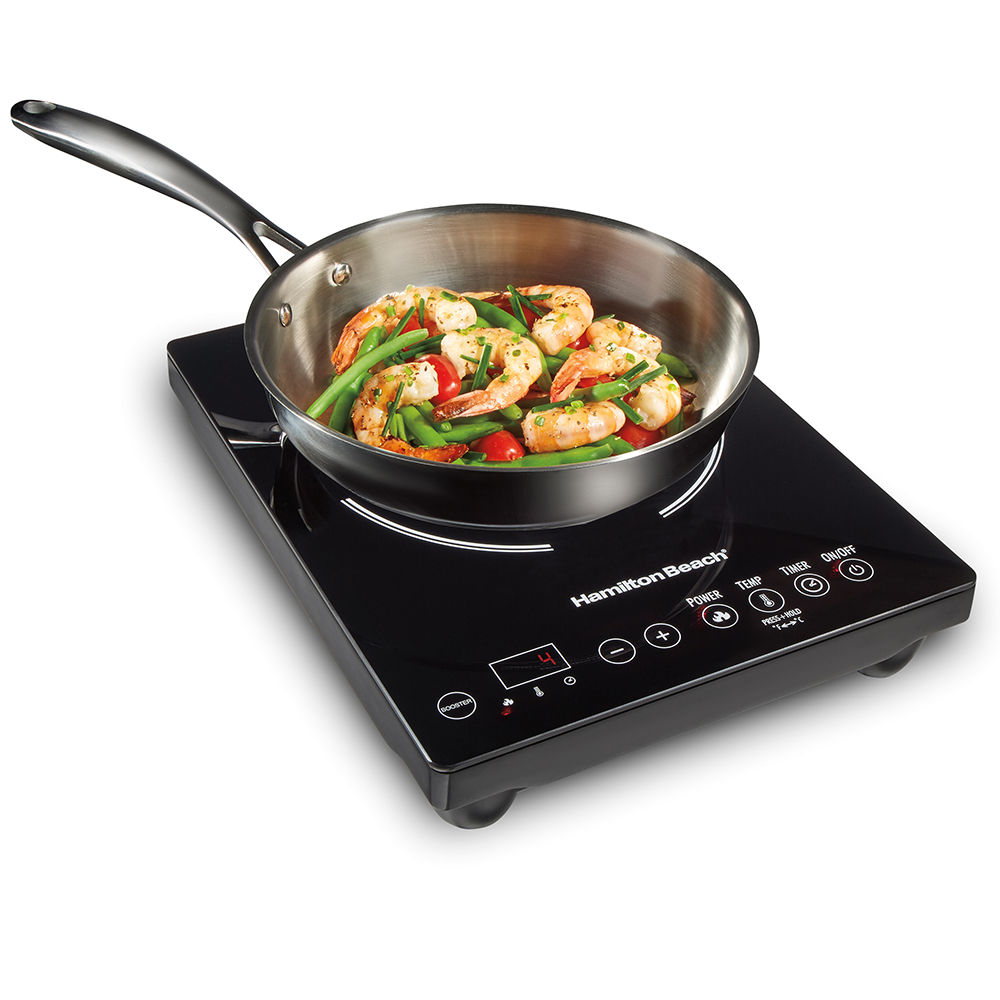
Many consumers are being introduced to induction cooking not via new range purchases but via inexpensive portable burners. The single element Hamilton Beach Induction Portable Cooktop, for example, retails for just $75 and plugs into a regular 110-volt outlet.
Sustainable and Safer
Concerns about climate change have spurred some municipalities to nudge the needle in favor of induction by banning gas. New York City has already banned the use of gas stoves and heaters in new construction starting in 2023, in part because gas stoves emit methane, a major contributor to global warming. And it’s a significant move, according to the non-profit environmental coalition New York Communities for Change, because New York City accounts for 5 percent of all gas consumed in buildings nationwide.
Other cities have also been part of the movement, including Berkeley and San Francisco in California. Meanwhile some states, such as Alabama, Oklahoma, and Tennessee, have passed so-called pre-emption laws that prohibit the institution of such bans. However, consumer preference is clearly moving away from gas, say appliance companies, no matter what the laws say.
Health is one reason. Varying amounts of gas leak from all home stoves, and as such represent a threat to consumers. A recent study of 69 homes in Boston by researchers from the Harvard T.H. Chan School of Public Health found that unburned indoor natural gas contained 21 toxins, including pollutants such as benzene that cause cancer and birth defects.
“More people are using electric induction versus gas due to safety concerns,” said Paula Pennington, senior product manager for Hamilton Beach Brands, “and it’s more energy efficient.”
Induction technology is more efficient because 90 percent of the energy it uses is transferred to heating the food, versus just 74 percent for traditional electric stovetops and a meager 40 percent for gas. That means less heat escapes into the kitchen, which in turn reduces the need for expensive air conditioning.
The primary reason induction is more efficient is due to the way it heats up pots and pans. A traditional electric burner first has to heat up the surface of the stove, which then in turn heats a pan, which then heats the food in the pan. Induction is inherently more efficient. It uses a coil under the cooktop’s ceramic surface to create a magnetic field that doesn’t heat the cooking surface but instead directly heats the pot on top by inducing an electric current in the pot’s metal. So the stove top stays cool while the pot gets hot.
Even if an induction element is accidentally turned on, without a pot or pan on the burner to complete the electromagnetic circuit, it won’t get hot, Williams pointed out. And when a pan is removed, the cooktop remains cool (aside from the warmth that was created by the pan). So induction stovetops can’t cause a fire the way an open gas flame or traditional electrical element can, making induction safer and more family friendly because tiny hands won’t get scorched.
Keeping cool also means less mess. If a pot boils over or spills, food will not get burnt into the surface like it can on traditional electric and gas stovetops. So it makes cleanups easy and more convenient.
Lastly, induction elements heat up food much more quickly than the competition. Boiling water, for example, takes about half the time it takes a standard electric stovetop to accomplish the same task.
Costs Coming Down
While luxury brands like Fisher & Paykel have been offering top-of-the-line induction cooktops for years,
induction is now available in all the mainstream consumer brands — and prices have come down accordingly. Still, shoppers will notice there can be price premium for ranges with induction cooktops. A Frigidaire Gallery stainless steel range, for example, retails for $1,298 compared to a similarly sized Frigidaire electric range in stainless steel that can be had for $898. However, some of the price difference is due to other, more sophisticated features in the induction model (such as built-in air fryer).
If a consumer is switching from a standard electric range to an induction model, aside from the cost of the appliance, there aren’t any associated installation expenses: both types typically use a 240-volt electrical outlet. However, if a buyer is switching from gas to induction, a call to an electrician will likely be in order.
However, Hamilton Beach’s Pennington points out that many consumers are being introduced to induction cooking not via new range purchases but via inexpensive portable burners. The single element Hamilton Beach Induction Portable Cooktop, for example, retails for just $75 and plugs into a regular 110-volt outlet.
“Portable induction and fifth burner cooktops were up 44 percent in 2021 vs. 2020,” said Pennington. Pre-pandemic customs like hosting large family gatherings are back, Pennington notes, and “consumers are using induction cooktops as an extension of their kitchen.”
Cookware is Hot, Too
Aside from some consumer culinary adjustments, induction cooktops also require particular types of cookware. Thankfully, most manufacturers have already made the move and offer complete lines of “induction compatible” pot and pans.
In order to use the magnetic field it generates to create an electrical current and heat a pot, induction burners require cookware that has contains some iron content. So iron
skillets, enamel iron dutch ovens and stainless steel pieces all work well. Copper and aluminum pots do not. (Rule of thumb: if a magnet sticks to the bottom of a pot,
it will work on an induction burner.)
Many manufacturers have anticipated the induction trend and have found ways to add stainless steel layers to their kitchenware — including non-stick models — so that most product lines now are induction ready. We tested out Anolon’s Accolade cookware as an example of the trend of ready for anything — gas, electric or induction — cookware.
An Anolon Accolade Cookware 10-piece set is $350. It features an extra thick base for even heating and a magnetized stainless-steel layer making it ideal for induction cooktops. The Accolade set also has a hard-anodized, non-stick (PFOA-free) coating that is typically more durable than, say, that found on ceramic cookware. The Accolade line is dishwasher safe and can be used with metal utensils — although we recommend consumers avoid both.
One thing they don’t have to avoid, however, are gas burners. We tested the Accolade set, which includes two covered saucepans (1.75 and 2.5 quart), a covered stockpot (7.5 quart), and a covered saute pan (10-in.), on a gas stovetop without a problem. Even with an uneven direct flames, the cookware didn’t produce unwanted hot spots. Conversely, we found the Accolade pieces were relatively quick to heat up on a traditional electric burner.
As one might expect, the Anolon cookware worked extremely well with induction cooktops. We could easily and quickly control the
heat, and the pots and pans were very responsive, particularly with regard to reducing the temperature. So when things got overheated, it meant we could correct our cooking misjudgments quickly. Compare that to iron skillets, which retain the heat long after the burner is lowered or turned off.
The Anolon Accolade set is definitely attractive enough to entice consumers making the switch to induction to also upgrade their cookware. And while the transition to induction cooktops will take time, Serena Williams says Meyer is already seeing an effect on sales. Induction cookware grew by 3.1 percent in 2021, for example, and is projected to grow another 4.2 percent over the next two years. In other words, induction is making cookware hot.


MOST POWERFUL WOMAN IN CE TECH AWARDS 2022
Most Powerful Woman
in CE Tech Awards 2022
This annual program acknowledges the contributions of women to the betterment of the consumer tech business. Despite challenging times in supply chain disruptions and labor shortages, these women have shown that they have what it takes to lead, rally and mentor others within their business and inside of their network. This group helps move the consumer tech industry forward with a diversity of ideas and perspectives.
From all of us at Dealerscope, congratulations to all of the 2022 honorees.
We asked each honoree three questions:



What attracted you to a career in consumer technology?
What makes consumer technology a good career choice for for women?
What hurdles remain for women to overcome in the CE industry?


Sarah Atkinson
National Business Development Manager
Sonos
I came from the building industry, which involves a more traditional way of working. I was excited about consumer technology because it gave me the opportunity to push boundaries, be creative and try things that hadn’t been done before. After completing my master’s degree and holding a number of marketing and business development positions in the builder world, I decided that I would like to jump into a new space and apply the knowledge I had gained from my experiences in new and innovative ways. When the opportunity arose to work for Sonos, to say I was excited is an understatement! Being a personal Sonos user (and married to the ultimate Sonos fan) definitely powered my decision to apply for the role. Supporting the installed olutions channel was also the perfect way to apply my previous experience while having an opportunity to try something new at Sonos. It was the dream role I was looking for.
Coming from an industry that was even more predominantly male, I entered consumer technology assuming it would be a great fit for me as a woman! In my previous role, I was the only female territory sales manager, and our customer base was primarily male as well. Because of that experience, I found making the switch relatively seamless, especially given Sonos’ commitment to diversity and inclusion. Any company who values product innovation would be remiss to not bring a wide range of perspectives to the table, which includes bringing more women onboard. For those women who may be considering a career in consumer technology, I personally couldn’t recommend it more. Go get it!
It is the reality that currently the CE industry is predominantly male, but that does not have to stand in our way. Be vocal about what you need, foster change when you can, and, absolutely, make allies who can support you along the way. As an example, being a new mom on a team that is entirely male required more individual planning for my maternity leave than I had anticipated. Since then, Sonos has evolved its paternal leave policy too, which is wonderful. I will admit I never gave much thought to parental leave policies earlier in my career, but the entire time while out on leave I realized the importance and felt so grateful to work for an industry and company that supports parents.


Annie Bloomquist
Executive Vice President and Chief Innovation Officer
Sleep Number
I transitioned to consumer durables after starting my career in retail merchandising. This quickly became a journey to re-imagine businesses, focusing on how people live, staying ahead of the rapidly changing technology industry, and most importantly, staying ahead of consumer changes. Together, with the Sleep Number organization, we merged technology with choices that were not previously available to create leading sleep and wellness innovations. Every day, it’s about putting the vision, strategy, operations and talent at the forefront to deliver meaningful consumer benefits based on consumer trends and preferences, resulting in revenue and profit growth. Ultimately, my team of experts, partners and I turned Sleep Number from a mattress company into a sleep and wellness technology leader.
A career in consumer technology is ideal for anyone attuned to demographic trends, particularly those able to envision breakthrough products or services that meet consumer needs. It’s a great choice for those who can visualize growth, remain steadfast on the strategy and are ready to continuously innovate with their customers at the core of their work. Women in any field can also succeed in tech. My advice to them: focus on the customer experience and surround yourself with a broad range of experts to grow your skillset, collaborate with and help you find the right path.
We know women are underrepresented in tech, and I believe brands must bear the responsibility of solving this issue. It is up to companies to help train-in young women that can be put in tech leadership roles, even if that’s not their original field of expertise. Brands must take chances and offer coaching, professional development, work-life balance, clear career advancement opportunities and mentorship and DE&I programs.


Kelly Davis
Chief Strategy Officer, SVP of Operations
Sony Electronics
What attracted me to CE early in my career wasn’t the tech. It was about being a part of a global brand and business. I was, and still am, passionate about problem solving and driving the business. Over time, my interest grew in launching new technologies. Learning how to market a new product that could enhance consumers’ lives was exciting.
Over the past 25 years I’ve seen the CE industry go through its changes. What once was mainly about hardware now is about operations, services, data and running the business as much as the technology it’s supporting. This provides career growth and opportunities for women beyond traditional product and tech roles and opens the door to move cross functionally in areas such as logistics, service, customer experience and others.
It has been an evolution vs. revolution. The CE customer has changed. More women are purchasing tech products than ever before, and the diversity of the decision makers needs to reflect that. While there has been growth in CE female leadership, where we need to see more representation is in the C-suite. This will drive change, bring a different perspective to the table, better reflect the needs of our consumers and ultimately grow our business.


Christina Chambers
Executive Director
The NPD Group, LP
Consumer technology is such an immense and evolving part of our everyday lives. Technology is the ultimate enabler for consumers, and the opportunity to impact the trajectory of devices, tools and experiences that make life better was and remains the most attractive aspect of my job. The extensive number of career paths in consumer tech represents an opportunity for a diverse workforce that includes more women and the strengths they bring to the industry.
The evolution of technology has the power to reshape our world. It only makes sense that women should be represented in not only the use of technology but in the process of charting the course. It is imperative that we as women bring a diversity of thought and a viewpoint to the tech space that cements our place in the industry but also forges a path for the women and technology of the future.
Women remain largely underrepresented in the consumer tech industry. This is a hurdle that we must continue to strive to overcome. We must continue to remain attentive to core issues such as pay disparity and gender bias that dissuade women from pursuing careers in traditionally male dominated industries.


Melody Craigmyle
Vice President of Marketing and Communications
Exertis Almo
The challenge of working in the fast-paced environment that consumer technology presents has always been exciting and motivating to me. Women use consumer technology, so I’ve always believed it’s critical that the female industry voice is represented. Women inclusion is crucial to a company’s success.
There is more awareness and acceptance of women in CE. Studies show that more roles being filled by women leads to better organizational outcomes, as women are more likely to influence their company and its culture. As technology continues to make appearances in households, high gender inclusivity in the tech industry not only creates value for female consumers but can also help boost the economy as a whole. Women also create value through thought diversity.
Women in CE must continue to find their seat at the decision-making table – in both the day-to-day efforts and overall bottom-line results. Simply put, if 50 percent of the population is missing from the conversation, companies are missing half the opportunities. While many have realized this deficit and are becoming more diverse, others still have a long way to go. But overall, many positive strides have been made, especially in the last few years.


Melissa Magner
Director
Brookstone, Electronics, Travel & Toys
I guess you can say consumer tech found me to some degree. Landing a job as an assistant buyer for consumer electronics business quickly led to my growth within this category. The ever-changing, fast-paced environment is what continues to stick with me. It’s a very fun and exciting industry to be in that is constantly evolving. And for how big this industry seems to be, you develop many relationships that last a lifetime.
Women offer different ways of thinking, and with nearly half of consumers being women, it only makes sense to have half of manufacturing, design, and marketing done by women. If you are looking to influence, change and innovate, this is an industry for you.
I believe the only true hurdle we face as women in this industry is that there aren’t enough of us. We must empower and be role models for our peers and future women CE leaders.


Jennifer Mallett
CEO/Founder
Level Up Automation
From a young age, I’ve always loved technology. My father worked for a large consumer computer company in the 80’s, and I remember seeing the very first versions of a computer mouse and laptop ever developed. I was in awe of the innovations. At 14, I began working for my family’s start up IT firm, which immersed me in the excitement and fast pace of the industry.
The technology industry is exciting, fast paced and women are underrepresented. Getting into the industry provides unique perspectives and voices that are needed to help our industry continue to innovate and grow.
Diversity brings us strength at all levels in our industry. Research shows we create stronger companies, teams and cultures when we have people from many different backgrounds contributing to our goals. Gender biases remain in existence from entry level roles to executives. It’s important for women to continue to push through and create their own paths in the industry.


Jamy Reyes
Marketing Manager, North America
Envision Peripherals Inc.
I became fascinated with the process of product manufacturing and the technology and innovation that came with it while doing public relations for a computer hardware manufacturer.
I was lucky enough to spearhead a media tour to China, where we visited factories and saw our products come to life. After this, it was clear that I wanted to continue pursuing tech. As a storyteller, I wanted to be at the forefront of this fast-evolving industry. The tech world is constantly advancing, which means that there are many exciting challenges ahead and plenty of opportunities.
Consumer technology is a good career choice for women because we are consumers of technology just as much as men. It would be a beautiful thing to see more women occupying roles in this male-dominated industry and contributing female perspectives.
Hurdles for women in this industry is the lack of C-level position being filled by them. The ratio of men to women filling C-level positions is still extremely low. This list is inspiring, and I am ecstatic to see more and more publications recognizing and empowering women.


Katie Springer
Vice President of Operations
Invixion Inc.
My career in the consumer technology industry started out through a pursuit of change and growth. My natural curiosity to learn is what sparked my initial intrigue for this field. Consumer technology helps us have better experiences in life, and my introduction to the audio industry sparked a passion to help create that for others. In an industry that is dominated by males, it allowed me a chance to provide additional perspective and value.
Along my career journey, I have found the consumer technology industry to be an engaging field with rewarding potential for future opportunity and growth as technology continuously evolves, especially for women tech leaders. More women are still needed in core business and decision-making positions to help continue to diversify the industry. Women are key consumers in the market and should also play more key roles in the business. The industry will continue to grow as technology progresses, making it a great industry for a career.
There will be challenging experiences faced, just like in any other industry, but I would not say that there are hurdles to overcome for women to enter the industry. I have met amazing women in the CE industry who serve as role models and a network to rely on. The industry is striving to empower women and create an environment to thrive. When I first started, although it was male-dominated, I did not feel like being a woman hindered me from being successful in the field. I was supported and asked for my perspective including how the industry could improve on some of the common negative experiences that women encounter. The industry continues to strive for improvement and will strengthen as diversity grows.


Sue Toscano
President
Toscano Communications
I had a degree in communications but no work experience in public relations when, through a mutual friend, I landed the opportunity of a lifetime with Nicoll PR. I soon realized what a fantastic opportunity I’d been given to work closely with many exciting companies from all over the world; the clients represented by Lucette and John Nicoll were the best and brightest in the high-performance audio/video category.
I recently celebrated 25 years in this amazing industry, the last five years as president of my own company, Toscano Communications — something I could never have imagined when I first started. It’s been an incredible journey, and a privilege to work with some of the industry’s most brilliant pioneers and visionaries. Year after year, the women I’ve read about in these pages have been talented people who have carved out long careers for themselves. I’m always inspired by their stories and grateful to them for helping shape my own experiences and providing me with the opportunity to succeed in this challenging industry. I see all that as strong evidence that the CE space can be a fantastic option for any woman seeking a dynamic, challenging and exciting career. And now, with the widespread adoption of work-from-home practices, there has never been a better time for women to enter the consumer technology business. Many global CE companies have recognized the importance of a well-balanced work/family situation, and they help provide the necessary tools to achieve that objective. It’s a dramatic improvement.
There are now so many resources for mentorship and networking available that I see no hurdles for women in this space. I feel fortunate to have been surrounded by strong, talented women from the moment I entered the industry, especially Lucette Nicoll, my mentor and chief supporter, and an acknowledged trailblazer for women in CE. I was lucky to begin my journey in this industry under her guidance. This industry moves fast, and no one advances or survives alone. Find your people, build your network and get ready for an exciting ride. Now, more than ever, there is an opportunity for everyone — and most important, it’s just so much fun!


Michelle Troupe
PA IFEC Supplier Management
Boeing
I have stayed in CE Tech for nearly 28 years because of getting to see incredible video displays and hearing the best audio products in the world. CE is an industry where people are genuinely excited and proud of new developments coming out. I was fully involved in showcasing to our clients the world debuts or first-to-market products from our top brand partners. My job in CE Procurement was never dull. I learned so much from working for Mark Ormiston and Craig Abplanalp throughout my tenure at Definitive. Recently, I found a place in aerospace where my considerable CE experience is an asset. The In-Flight Entertainment and Connectivity team at Boeing intertwined my audio and video knowledge so that I can directly apply it to procuring a/v products and finessing supplier management proficiencies to my new role.
I believe that opportunities abound for women to have a stronger voice and to fill leadership and executive roles in consumer tech companies. This is where women can get immense exposure to develop their interests in all aspects of business. Unlike giant corporations where there are several layers between you and the final decision makers, in this industry it’s easier and more attainable to reach business owners and executives. There are so many opportunities to learn at the beginning of your career or to apply your vast experiences to this industry. There are no limits for women who want to contribute, create and invent in CE Tech!
One hurdle to overcome is attracting women from other industries to consider CE for their careers. Awareness and education should begin in high school and college, as students consider their future career choices. If CE can interweave with other industries to work together and create a dynamic approach, it would be easier to reach a boarder audience and a better chance of attracting more women into the industry. My new position in aerospace with my CE experience is an example of needing to think outside the box to include and diversify what CE Tech means. I believe CE Tech can achieve this and will continue to evolve throughout the near future.


Amanda Wildman
Chief Experience Officer
TruMedia
I have always been interested in technology and science, but I have to admit that I actually stumbled into this career through my husband. We started TruMedia in 2003 when he decided to go out on his own to sell and install satellite systems. In 2014, we pivoted the business into the custom integration channel and in 2020, we added an electrical division to our business. While I dabbled in the field during our satellite days, my involvement really took off when we became integrators. I really enjoy the process of getting to know our clients, how they use their space and how technology can enhance that experience in their homes. While the business has continued to grow, I still try to spend as much time as I can in the field and learning, earning and creating certifications and licenses in the industry. I find this industry an amazing opportunity to use my creativity and problem-solving skills to design solutions for our clients to simplify and enhance their lives.
This industry is ripe with opportunities for women to excel in it. We as an industry are changing from seeing what technology can DO for us and moving into a time where we look to see how technology can make us FEEL. Women in the industry can be uniquely gifted in designing the ‘hyper-personalization’ that our clients are looking for. I am also proud to say that we have more supporters and allies than perhaps ever before and I am excited for what the future holds for the women in our industry!
I believe we as an industry have come a long way in recognizing and valuing women. It certainly hasn’t always been easy, but we have many women (and male allies) who have paved the way. While we are still paving the way, the most common hurdle that I believe still exists is the notion of seeing it as women vs. men (or men vs. women), when in actuality it should be treated as a partnership. When you get smart people in the room no matter their gender, amazing things happen when you support each other. That’s how we remove the hurdles as one cohesive unit.
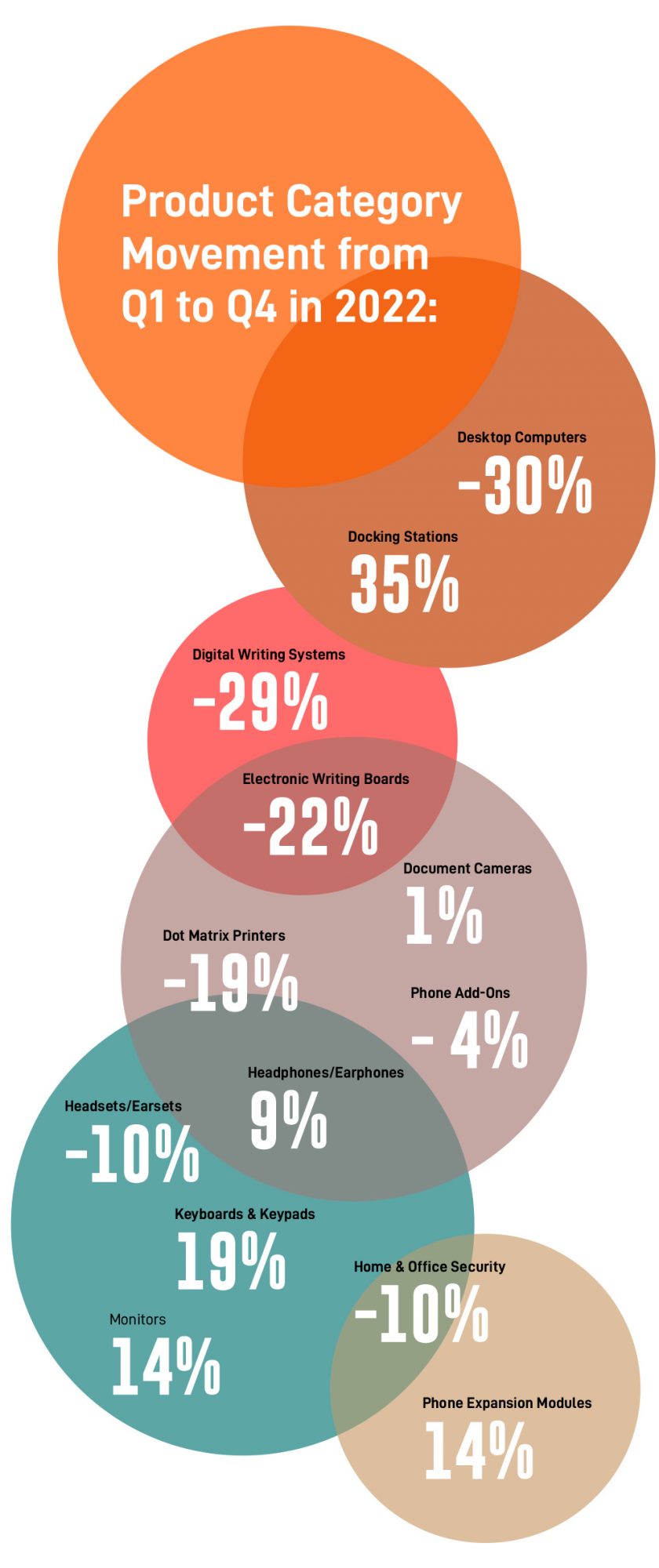

DATA
What the Numbers Say
About Office Tech Products
An immersive data study shows what’s popular
and what’s not in this ever-growing category
COMPILED BY GFK AND ETILIZE
Desktop computers impressions were down 30 percent during the time reviewed. Possible reasons were that desktops are most commonly used in an office environment. During the final questers of 2021, the majority of workers were still working remotely. In addition, industrial output of new products slowed down post lockdown. During the lockdown, new product development was pushed back as manufacturers struggled with both the market and reduced production.
Digital writing systems impressions were down 29 percent. This category includes digital note pads, presentation systems and noting systems. As in desktop computers, these categories are most often used in group meetings, of which there were few in the later quarters of 2021.
Methodology: More than 443 million impressions were reviewed to determine trends. GfK records image impressions from a large group of channel partners made up of resellers, distributors, government and corporate users of GfK product catalogs. The channel partners are primarily in North America and include most but not all of GfK’s network. GfK records an image impression when a third user requests a product page (PDP) that contains the primary image of a product. Rules are applied to prevent the same user’s shopping journey from being counted more than one. From image impressions, GfK can determine the product identification, category, city, country and other differentiating data.


CONNECTED HOME
The Potential Behind
Digital Twin Technology
How an evolving concept can change
the future of connected living
By Jeff Unterreiner, president of U.S. Connected Living at Assurant
What if you could walk into a customer’s home, test the configuration of their disparate network of connected products, identify devices and appliances that are out of date or about to fail and then offer solutions to optimize and ensure their network keeps running smoothly? And you could do this all without causing the customer any disruption or inconvenience?
“Digital twin” is a concept that has promising implications for a wide range of industries, including consumer electronics. It refers to technology that can create a virtual environment that mirrors the real world in order to conduct simulations in a non-invasive way and predict performances and outcomes. It has the potential to shape the future of connected living and enable a more sustainable future.
NASA was one of the originators of this idea back in analog times, when it built physical mockups of space capsules on the ground to help reproduce and solve problems in their vehicles in orbit. Today’s engineers use virtual representations of actual spacecraft to do the same thing.
A digital twin can be built based on data from connected products, sensors, cameras and other IoT equipment and modeled using AI, machine learning, virtual reality and other approaches to replicate the ever-changing real world in real time. As more products become connected, adding to the data flow and complexity of networks, creating such an accurate and dynamic duplicate of a changing environment is essential to testing and calculating the impact of ‘what if’ scenarios.


A Better Connected Home Experience
For retailers, there is the potential to deliver a richer consumer experience from the mix of smart appliances and devices within the connected home. This could include round-the-clock support and protection to ensure the network works continuously and efficiently as new products are added.
A digital twin of the home could be built by tapping into and utilizing the operational data and configuration of connected products, providing a holistic view for testing, remote monitoring and management. Based on the performance and efficiency of devices and appliances, the digital twin could monitor and alert the consumer if servicing or replacing is recommended. For example, once an air conditioning unit, Wi-Fi camera system or washing machine has reached a certain threshold of run time, the digital twin could notify the retailer or manufacturer and the consumer simultaneously and automatically arrange an appointment for maintenance and service or to discuss an upgrade or replacement if needed.
Having a digital replica of a house or an apartment also could enable people to make smarter decisions when renting or purchasing a property. For instance, a digital twin could provide the consumer with a 360-degree view of the premises, including the condition and age of existing appliances and devices, the length of time they’ve been operating, service history, energy consumption and so on. Once a person moves in, appliance and device manufacturers could get notified, enabling them to proactively reach out to offer services and maintenance for the onsite products.
A More Sustainable Future
In addition to providing a better user experience, digital twin technology has the potential to help create a more sustainable environment by optimizing trade-in and upgrade programs for a wide range of connected home devices and appliances. Knowing the age, usage and performance of a connected product, retailers and other electronics providers could proactively provide the customer with a trade-in offer to upgrade to newer models. This would promote new sales and incentivize consumers to return their used devices, which can be refurbished and resold in the secondary market, extending their life and feeding the circular economy.
I can tell you firsthand as part of Assurant, which has repurposed more than 125 million devices, that such efforts have a significant impact on keeping e-waste out of landfills and improving connectivity for many who could not otherwise afford it through access to affordable pre-owned technology.
Current Use Cases
Digital twins are already being utilized in several industries, including manufacturing, automotive, logistics and healthcare. Applications include new product development, facility configuration and performance, autonomous vehicle testing, process optimization and predictive maintenance.
While there are examples like Sofi Stadium, home to the LA Rams and LA Chargers, which has its own digital twin to help manage, maintain and operate the building, most current use cases can be found among energy plants and industrial operations. An aluminum smelting factory in China has created a digital twin in which they model and test operational processes and worker/machine configuration and interaction. Complex modeling has led to solutions that have resulted in a 90 million kW/hour reduction in power usage, roughly equivalent to the energy consumption of 13,000 residents in New York City.
It’s still early days. The potential of digital twins to enable enterprises to improve efficiency and performance, to transform homes and connected lifestyles and to promote greater environmental sustainability is just starting to come into focus. However, the promise is there for utilizing the technology to help businesses and consumers alike thrive in a connected world.
KEY TAKEAWAYS:
- A digital twin mirrors the real world in order to conduct simulations
in a non-invasive way and predict outcomes. - This concept could help create a more sustainable environment
by optimizing trade-in and upgrade programs. - A digital twin of a smart home could monitor and alert the consumer
if servicing or replacing is recommended.
GAMING
Elevating Games
College students rely on superior gaming electronics for engagement, connectivity and content creation
By Fred Towns, President, New Age Electronics
One positive outcome of the digital shift brought on by the pandemic is the adoption of high-quality electronics to complement new ways of working and learning. We know this is evident in hybrid workplaces, but it is just as prevalent in colleges and universities. Students are especially savvy consumers of gaming electronics, and it’s important for them to feel connected with others. Having the right accessories, like a microphone with crystal clear audio and a stable and reliable keyboard can make all the difference in a gaming experience that complements online classes as well.
Computer microphones promote dynamic communication in any recording situation
College campuses are ripe for digital engagement, especially when it comes to gaming and e-sports. Even though many universities have reverted to in-person learning, many aspects of digital learning are either here to stay, or students have carried over the capabilities into their free time as an extension of their social lives. Retailers should be prepared to offer a range of products to fit collegiate consumers’ needs.
Microphones play a huge role in promoting digital engagement, especially those that can withstand the rumbles of daily life and help mitigate background nose. When friends get together for a round of e-sports, high quality mics like the HyperX QuadCast S offer optimal sound quality that reduces echo and other disruptive effects for a better gaming experience.
We’ve seen a wave of young content creators on college campuses with the rising popularity of podcasts. Being able to create an engaging platform where students can dive into a topic that interests them is a great way to explore the medium, and having a microphone that is portable and durable while also achieving professional broadcast quality is a gamechanger.
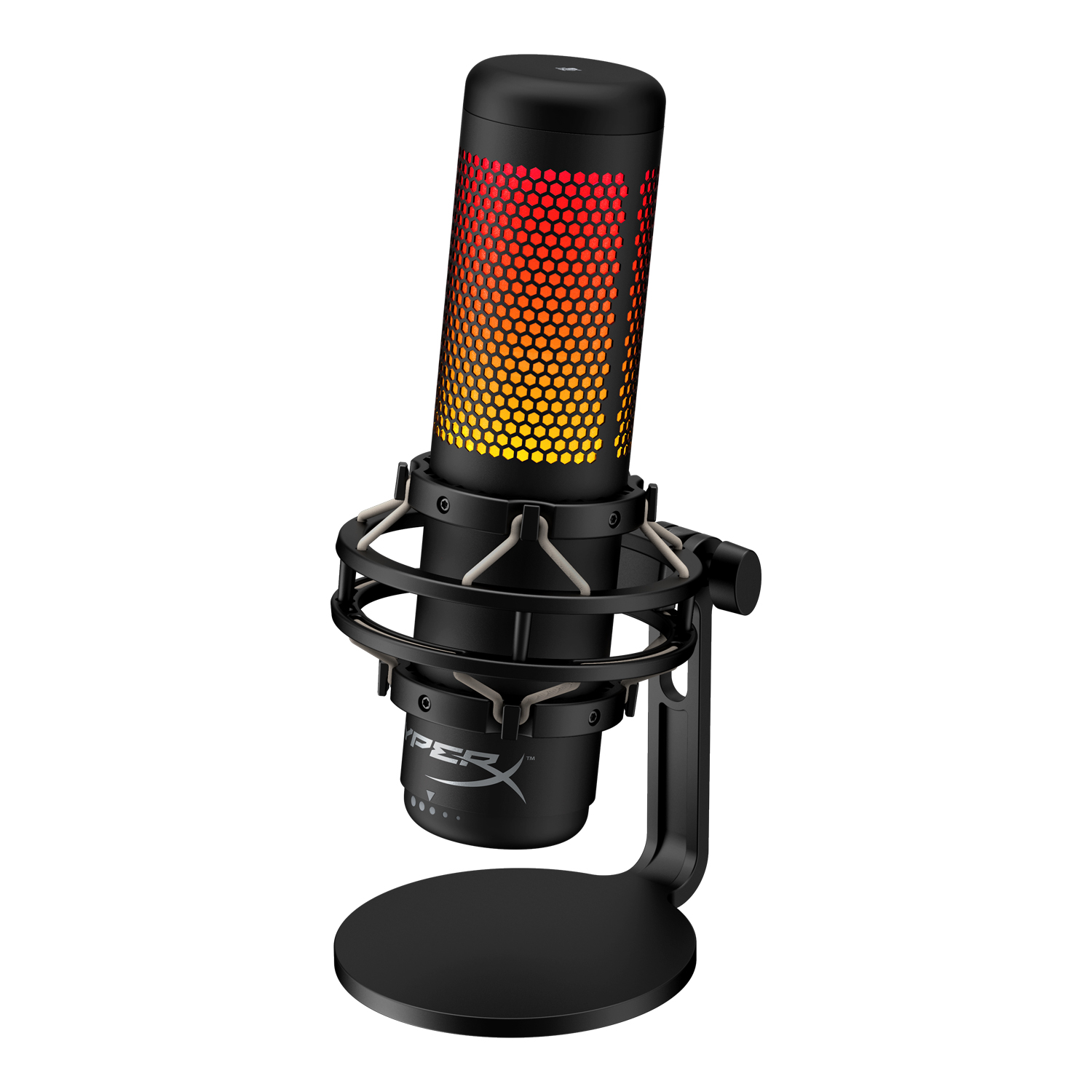

The stunning RGB lighting and dynamic effects of the HyperX QuadCast S adds style to any stream or setup and is customizable via HyperX NGENUITY software. This all-inclusive mic features an anti-vibration shock mount and built-in pop filter to help muffle plosive sounds.
Keyboards that are both reliable and durable can also be stylish and tactile
Gaming keyboards across the market have a number of components that enhance user experience. While opinions differ on what features are most important, there are a few that stand out as must-haves. Wired keyboards are essential, especially for gamers who want a competitive edge. Wired keyboards are 80 milliseconds faster than wireless ones, which, for serious gamers, makes a considerable difference. A USB portal allows for easy plug-and-play into the student’s computer and doesn’t require charging, since the power feeds into the keyboard from the computer. Durability is also key. College campuses are not always calm and still, especially when groups of people are gaming in the same room. Retailers should be able to offer keyboards that are designed for stability and reliability, spill-resistant and built to last. For students looking to enhance their keyboard’s style and performance without breaking the bank, HyperX Alloy Core RGBTM is ideal.
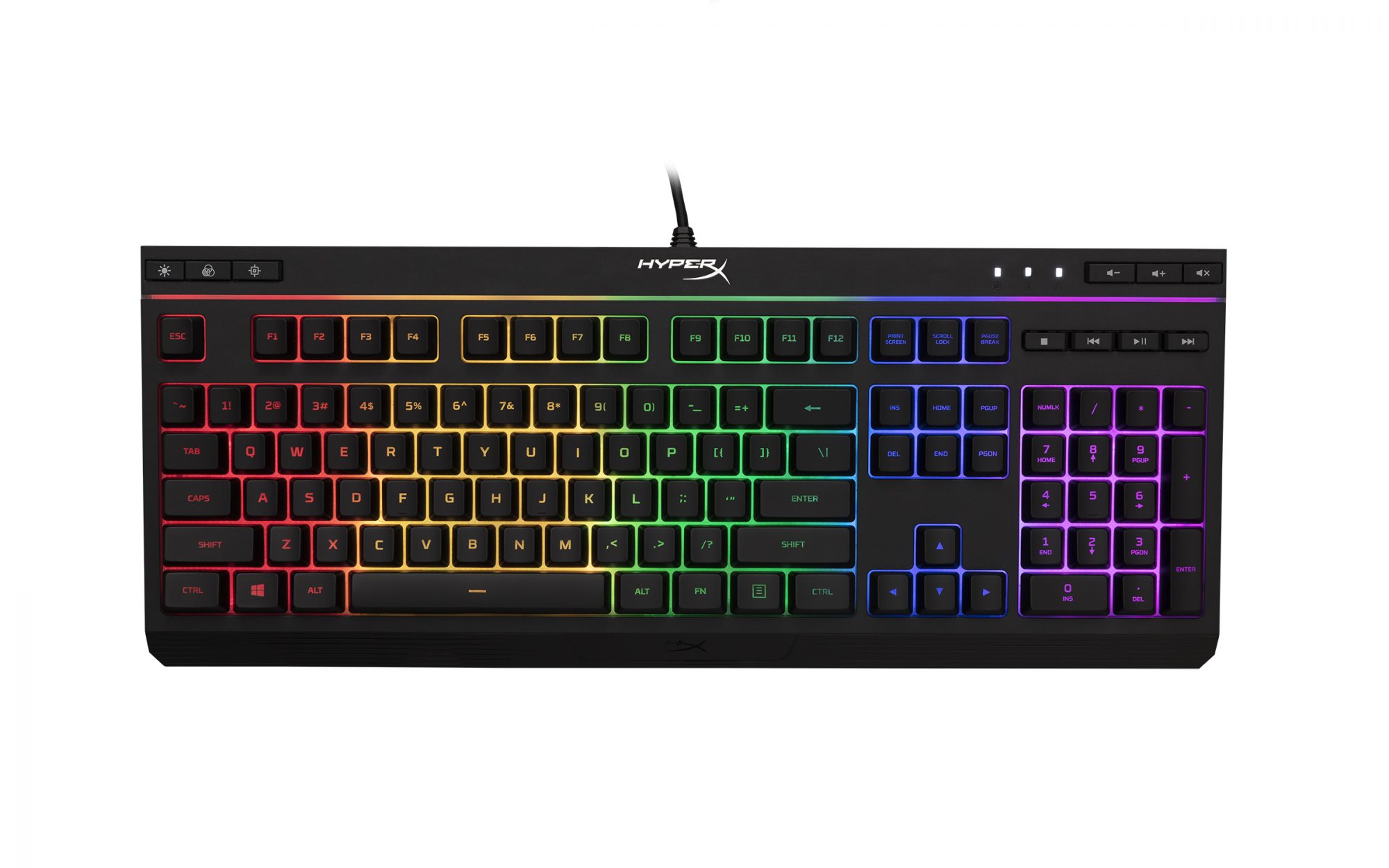

The HyperX Alloy Core RGBTM boasts its signature radiant light bar and smooth, dynamic lighting effects. Balancing both brilliance and budget, the dedicated media controls and quick access buttons place control right at your fingertips. It’s stylish, nicely featured, and durable – making it a great all-around multimedia keyboard for gamers.
Lighting Features Aren’t Just for Style
While many consumers love how the visual effects look, the backlit keyboards also help gamers see the keys more clearly. Tactile keys that are anti-ghosting are a must-have. Soft-touch keys that give the gamer some tactile feedback is helpful and satisfying but also quiet, which roommates would likely appreciate, especially if the user is going to use the keyboard for both gaming and homework.
100 percent anti-ghosting is also critical. In the heat of a competition, being able to tap as many keys as you can in little time is required to stay competitive.
Emerging from the pandemic, college campuses are mirroring many workplaces in their approach to in-person versus digital interaction. The good news is that they now have the flexibility to pick and choose what works best, resulting in hybrid solutions that are adaptable.
Retailers should not only be well-stocked with electronics that support the gaming industry, but also be prepared to advise consumers on the array of options that fit their needs, factoring in mobility, versatility, style, comfort and durability.
Cookware is Hot, Too
Aside from some consumer culinary adjustments, induction cooktops also require particular types of cookware. Thankfully, most manufacturers have already made the move and offer complete lines of “induction compatible” pot and pans.
In order to use the magnetic field it generates to create an electrical current and heat a pot, induction burners require cookware that has contains some iron content. So iron
skillets, enamel iron dutch ovens and stainless steel pieces all work well. Copper and aluminum pots do not. (Rule of thumb: if a magnet sticks to the bottom of a pot,
it will work on an induction burner.)
Many manufacturers have anticipated the induction trend and have found ways to add stainless steel layers to their kitchenware — including non-stick models — so that most product lines now are induction ready. We tested out Anolon’s Accolade cookware as an example of the trend of ready for anything — gas, electric or induction — cookware.
An Anolon Accolade Cookware 10-piece set is $350. It features an extra thick base for even heating and a magnetized stainless-steel layer making it ideal for induction cooktops. The Accolade set also has a hard-anodized, non-stick (PFOA-free) coating that is typically more durable than, say, that found on ceramic cookware. The Accolade line is dishwasher safe and can be used with metal utensils — although we recommend consumers avoid both.
One thing they don’t have to avoid, however, are gas burners. We tested the Accolade set, which includes two covered saucepans (1.75 and 2.5 quart), a covered stockpot (7.5 quart), and a covered saute pan (10-in.), on a gas stovetop without a problem. Even with an uneven direct flames, the cookware didn’t produce unwanted hot spots. Conversely, we found the Accolade pieces were relatively quick to heat up on a traditional electric burner.
As one might expect, the Anolon cookware worked extremely well with induction cooktops. We could easily and quickly control the
heat, and the pots and pans were very responsive, particularly with regard to reducing the temperature. So when things got overheated, it meant we could correct our cooking misjudgments quickly. Compare that to iron skillets, which retain the heat long after the burner is lowered or turned off.
The Anolon Accolade set is definitely attractive enough to entice consumers making the switch to induction to also upgrade their cookware. And while the transition to induction cooktops will take time, Serena Williams says Meyer is already seeing an effect on sales. Induction cookware grew by 3.1 percent in 2021, for example, and is projected to grow another 4.2 percent over the next two years. In other words, induction is making cookware hot.
CRYPTOCURRENCY
The Rising Figures of the
Blockchain Universe 2022
An inside look at crypto events
and the women driving the industry
By Brittany Mier y Terán
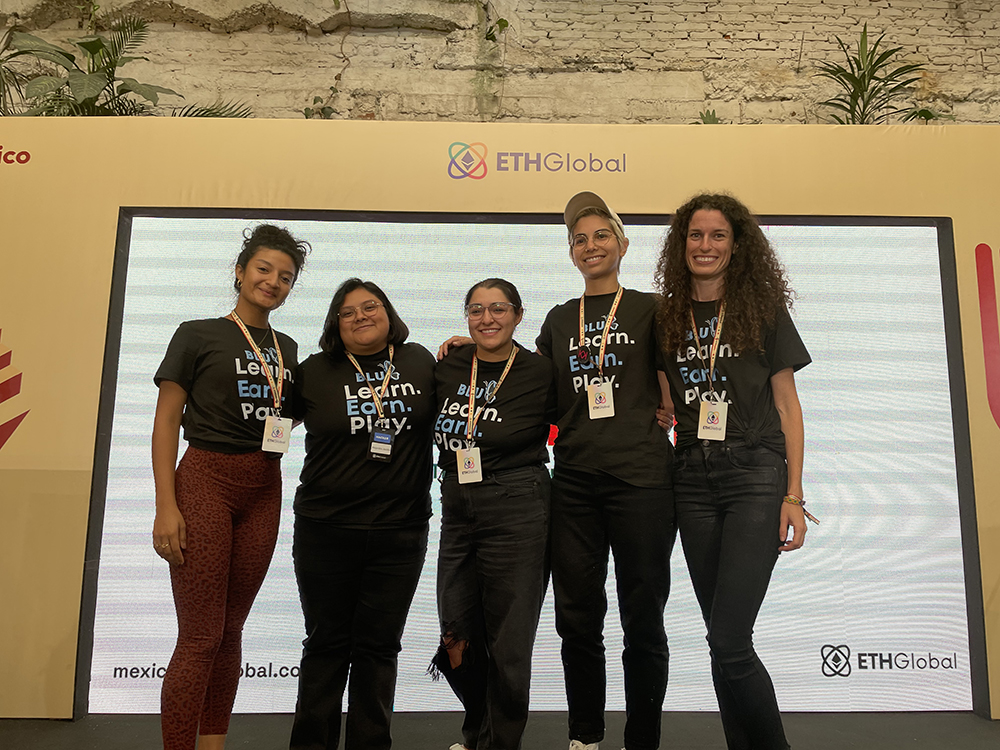

Fresh off a plane to Mexico, I walked into a house of 26 women who had spent the last 48 hours together, preparing to compete. These weren’t just any women. These women had swam upstream in a man’s world and had no intentions of slowing down. These women were strong, tenacious, confident, friendly and so welcoming to a newcomer like me: a newcomer who wasn’t sure exactly how a hackathon worked. Were we going to break something?
During a hackathon, you “hack,” or innovate, at a marathon pace. Our “hacker house” included women developers at Fortune 500 companies, Ivy League computer science graduates, and directors of blockchain at financial institutions.
This felt like the culmination of two years of exploration into the cryptocurrency and blockchain world, also known as “web 3.” Through a partnership between Blu3 DAO and Polygon, these 27 women were sponsored to compete for over $150,000 in prizes at ETHGlobal in Mexico City. Vitalik Buterin, co-founder of Ethereum, would even be speaking live in a masterclass on future uses of the protocol.
There are a lot of different niches in web 3; they are similar and different at the same time. It’s similar to the consumer electronics industry, where you find home theater, pro-av, security and retail all sharing many of the same vendors and technologies, with minimal event attendee cross-over. In cryptocurrency, events are either “protocol” based (i.e Bitcoin, Ethereum, Near etc.), or sector based (decentralized finance, NFTs, metaverse, regenerative finance, decentralized autonomous organizations, gaming and more). Many of these events include a hackathon or have many co-located hackathons. At all of these events, you will find developers, founders, venture capitalists, retail investors, Fortune 500 companies, NFT artists, lawyers, accountants, people dressed up in costumes and so much more. The balance of these attendee types relies on the niche of the conference or event, and they each have their space to shine.
ETHGlobal was about innovation on the Ethereum platform, more specifically how we plan to innovate and onboard the next billion users to the Ethereum blockchain. As hackathon participants, we were there to form teams, learn new protocols, build an app, compete for bounties (prize money), tweak, fix, change, pitch, and pitch again, in just 38 hours.
So why was I there? Because I had spent two years doing just about everything to understand this blockchain/cryptocurrency/NFT space that you hear about in the media, and curiosity got the best of me. I had gained early exposure to crypto through college friends, but maintained healthy skepticism and a duffle bag full of misconceptions.
Eventually 2020 came along and we all found ourselves sitting with more down time than we knew what to do with. Alongside endeavors to earn a degree in YouTube gardening, I started exploring the blockchain space. I can attest both interests have withstood the test of time.
My first crypto event was Miami Crypto Experience in 2021. This event was lighthearted, NFT focused, and much like you might imagine a “crypto event.” Luxury cars were raffled, and workshops offered on how to create your very own NFT. Although I ultimately left that event yet to be convinced that the industry knew what it wanted to be when it grew up, it was there that I realized just how welcoming the people in web 3 are. It is truly unbelievable. The night before the conference I unknowingly bumped into NFT/crypto influencers Kenn Bosak, Miss Teen Crypto, Miggy Crypto, and their cohort, who welcomed me into their evening’s adventures and spent the night answering my many, many, questions on what the heck an NFT actually was.


Fast forward to 2022, I found myself walking the venues of ETHDenver. More established than the Miami Crypto Experience, this event touted its very own buffalo unicorn mascot, event currency ($SPORK), adjacent DeadMau5 performance and incredible support from the Colorado government. It was like nothing I’d ever seen before. Something akin to a well-established GenZ science fair sprawling through downtown Denver. A street filled with food trucks fulfilled orders for eager event attendees, and amazingly this food, and the vast offerings inside, were included gratis with attendance (which was actually complimentary upon accepted application).
Again, I was welcomed warmly by the web 3 community. New and existing friendships with team members of FiO Protocol, KeepKey, ShapeShift DAO, Mandala, and SimpleDeFi, allowed me to roam alongside knowledgeable crypto folk and absorb. Once again I found myself asking many, many, questions. After ETHDenver, I was officially confused about cryptocurrency’s journey as an industry, albeit interested like never before.
ETHDenver was a momentous stop on my web 3 journey because for the first time, I spied a group of women roaming a crypto conference together. There were actually two groups! I took to Instagram to find out what they were about. I learned that they were the relatively new women’s organizations, H.E.R DAO and Blu3 DAO. DAO is a web 3 term for “decentralized autonomous organization,” i.e an organization run through a common mission statement and coded smart contracts. Their grounds for existence, benefits, risks and future applications are an article of its own. For today we will leave it that: “a DAO is an organization.” I instantly joined both groups on their preferred chat apps, Discord and Telegram.
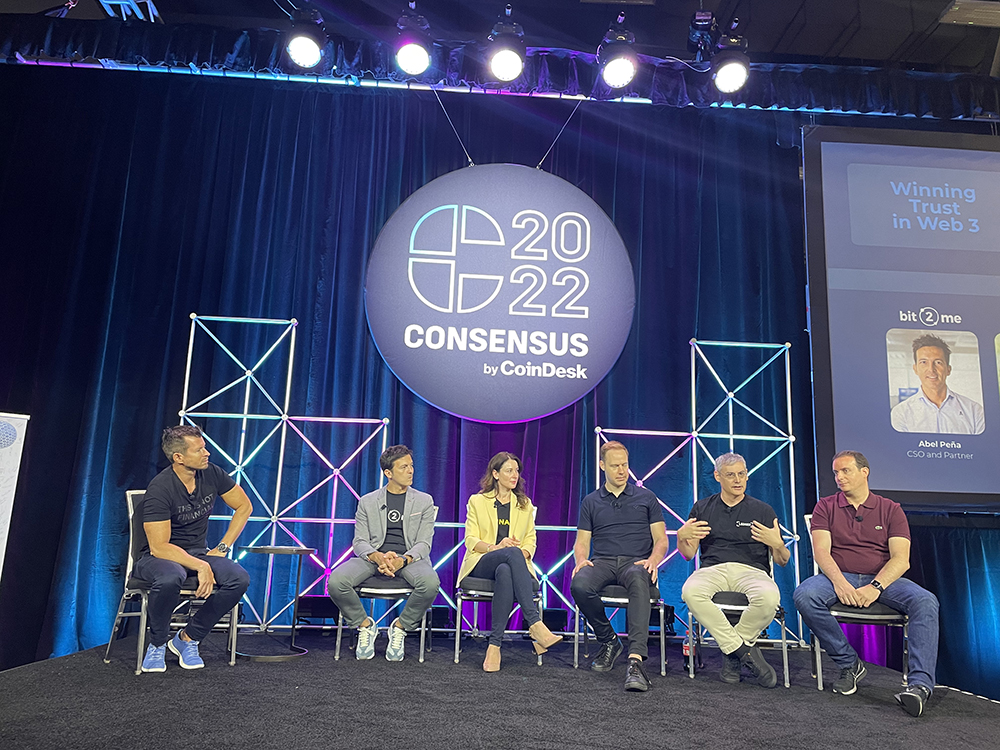

Several months later, I found myself riding scooters through the streets of Austin with five friends from ETHDenver. They were riding along to escort me to H.E.R. DAO’s womxn’s event during Consensus, a crypto conference in Texas. Much like being dropped off at an after-school program, they patiently waited at the adjacent restaurant as I timidly walked into a room full of ultra-smart women. I left that event inspired and excited. Upon leaving, I committed to finding a place to participate within web 3’s female world. I wanted to contribute to this mission of making web3 accessible and inviting for all.
This August, there was an announcement posted by both DAOs. They were opening applications for women to compete in Mexico at ETHGlobal. A moment of imposter syndrome and hesitation passed, and then I filled out the applications. What was the worst that could happen?
Three weeks later I was smiling ear to ear on the ETHMexico stage with Blu3 DAO as we celebrated a slew of awards and prizes amongst the teams. Through a partnership with Polygon, Blu3 DAO flew 27 women from around the world to Mexico city. This was an unprecedented amount of female competitors for any prior event. This accolade can be directly attributed to both Blu3 DAO and H.E.R DAO’s efforts.
Electronics, finance, art, transactions, verifications and so much more will ultimately evolve with the continued innovations of blockchain technology. Buzzwords like “NFT” will be replaced with less provoking words, like “digital certificate,” and mobile validation,” masking the underlying blockchain technology for the end consumer.
What clearly won’t change? The tenacity of the females in this space that are working nights and weekends to make sure that every single woman and girl has the opportunity to thrive in the blockchain universe.


DISTRIBUTOR ROUNDUP
Strategizing
for Stability
As COVID-19’s impact gradually abates, distributors tell how they’ve reset programs and priorities in sync with dealers’ needs and wants.
COMPILED BY NANCY KLOSEK



How are the direct and indirect effects of the pandemic impacting your business as a distributor lately? Have chip shortages, supply-chain disruptions, inflation and effects on consumer buying patterns eased — or do some or all of these factors continue to affect business? And in what innovative ways has your company tweaked its programs and policies for dealers to help them stabilize and grow their businesses through this time?


21st CENTURY DISTRIBUTING
Mike Pote, Marketing Director/Systems
Integration Specialist
As another pandemic year starts to wind down, we’re focused on improving on the successes we’ve had, as well as learning from any miscalculations we made dealing with business in the “new-normal” era.
21st Century Distributing, like everyone else, spent most of the year keeping an eye on supply chain issues, freight costs, consumer needs and inflation. We did begin the year expecting to capitalize on the investments and changes we implemented in 2021. We heavily invested in improving our infrastructure, delivery methods, warehousing facilities, training abilities, marketing efforts and making updates to both our mobile and desktop Web portals. Those changes allowed us to provide an even better experience for our customers and for our vendors.
Being strategically aligned with groups such as the PowerHouse Alliance, Azione, Nationwide and several dealer-direct programs allows 21st Century to provide our customers and our suppliers with the highest level of value and service we’ve ever been in the position to provide.


ALMO CORP.
Jack Halperin, Senior Vice President,
Dealer Channel Division
Despite the ongoing challenges the pandemic has presented, there has been a reversal in some of the business dynamics since CY20 & CY21. Overseas shipping container fees have dramatically been reduced from highs of more than $20,000 in mid-CY21 to now around $10,000. It’s worth noting, this is still higher than fees charged pre-pandemic.
In general, consumer demand for home appliances has also declined over the past four to five months. This should not be a total surprise, given the U.S. inflation factors. Select categories like higher-end dishwashers are still being impacted by microchip shortages; however, broader appliance manufacturing has started to get back to normal in categories such as laundry. Some would suggest manufacturers/distributors are now very well-stocked in select product segments. The builder segment for core appliances seems to be holding its own, but most shipments are still completing jobs already on the schedule from CY21.
Overall, dealers seem have a very cautious mindset right now, as no one really knows what the second half of CY22 will bring. We’re working very closely with our vendor partners to make sure our Almo inventory levels remain healthy and at acquisition costs that will allow us to keep our dealers competitive in the fourth quarter, regardless of what the broader industry delivers.


CATALYST AV
Helge Fischer, Executive Director
As, business is still being affected. We are seeing receivers in inventory, so things are getting slightly better, and we hope to see further improvements into 2023. In the meantime, integrators need to look into alternative solutions.
Consider installing the product in phases and RMR services by including 24/7 tech support, certain free or discounted services, anything that can let your customers know that everyone is trying their best. Also consider producing more generic AV designs to make changing out equipment easier. Initiate revenue streams such as surveillance and cameras, lighting and lighting fixtures and shading; these will continue to be hot product lines. And keep all levels of communication high. Your customers are used to many supply chain problems for everything from paper goods to baby formula. Talk, and communicate!


CLIMATIC HOME PRODUCTS
Doug Allen, President
The effects of the pandemic and inflation have continued to impact the appliance industry in 2022. The supply chain in many categories has corrected, as the industry slowed quicker than forecasted, therefore, leaving the appliance industry with high levels of inventories in some categories. RTO, credit and some new homes sales seem to be the segments of business that have slowed more than others.
At Climatic Home Products, we are working with our vendor partners to develop a plan to sell so we have the right products to ship to our customers. We continue to work with our customers to deliver “just in time” products and services to help in their businesses. During the remainder of 2022 and into 2023, our team will monitor the industry to stay ahead of the market as it evolves, and will advise our customers of these changes.


THE FESCO GROUP
Raymond Levy, COO
Fesco is celebrating its 60th birthday this year. Our business has changed slowly since 1962, yet when you look at where we started out and where we are now, the transformation is dramatic. Fesco – Foto Electric Supply Co. started out as a retail store, and turned into a local distributor, morphing eventually into a national distributor for global brands. Over the last 10 years, our focus has been on diversifying our portfolio by manufacturing our own brands. With a broad range of products and price-points, we always have something relevant for our customers regardless of shifts in the market.
One thing that hasn’t changed, and won’t, is that we treat our customers like family.


New Age Electronics
DIV. OF TD SYNNEX CORP.
Fred Towns, President
For many of the consumer IT categories, the supply constraints we were seeing during the pandemic have leveled off. Where we continue to see disruption/constraints is in the console gaming space, where both Xbox Series X and PlayStation 5 consoles remain constrained due to continued demand for these products from Sony and Microsoft.
The chip shortage and supply chain disruptions have eased; however, inflation continues to have a negative effect in the Consumer PC space. We are seeing declines from pandemic level sales, though we are expecting to see Consumer PC sales reset to pre-pandemic levels. We continue to use advanced analytics via our robust collaborative planning, forecasting and replenishment process to ensure product is forecast, delivered, promoted, and sold through in a timely manner, while also leveraging our vendor relationships to push for incremental retail promotions to help our retailers sell through inventory.


NEXT LEVEL DISTRIBUTION
Mark Garijanian, Director of Marketing
As shipments are arriving more steadily in 2022, we are fortunate enough to have a strong dealer network in various channels that affords us the ability to pick up the slack if needed. For example, while let’s say amplifiers were down due to the chip shortage, our TV and soundbar business grew. Our sales team is well trained and able to take care of our customers and pivot to a solution if needed. We’ve invested in our internal infrastructure to ensure maximum performance from our different divisions. [We’ve had] growth in our credit, HR and even hired sustainability and process improvement directors. I was hired to bolster the marketing efforts, which we’ve increased tenfold over the past six months. Our award-winning website has many advantages since business is never 9-5. Finally, we are back to hosting trainings in our different facilities. Over the past 45 days, we’ve hosted or will host six various in-house trainings as well as attended four tradeshow events. It is vital that we continue to get in front of our customers and show them the next level of service and support!


PowerHouse Alliance
Dennis Holzer, Executive Director
The PowerHouse Alliance is continuing to expand and we have been very strategic about the way we manage and acquire vendors and products across member locations. We have been diligent in expanding the number of vendors and products we offer not only to provide more variety, but to also give dealers the power of choice and better availability to meet their needs. While we are unfortunately still seeing some vendors in our industry struggle with product inventory, we know we are not alone here. Whenever PowerHouse has seen gaps in certain product categories, we work with our partners across the Alliance to meet the needs of dealers. Our competitive prices, rebates and rewards programs further support dealers as they navigate these tricky supply chain waters.


Snap One
Wally Whinna, Senior VP
While we have been able to take action to prevent shortages with our Snap One brands, it has come with higher costs for accelerated shipping and parts. Our inventory levels are higher than normal to ensure we have the products our partners need when they need it. In addition to our Master Distribution Centers, Snap One has 34 locations to draw inventory from, and we have no problem transferring product between branches or shipping direct to the dealer from any location. In 2022, we implemented a much more aggressive Free Freight program, saving our partners money. Our Partner Rewards Program has also extended to TVs and other brands we sell. We are once again hosting monthly in-person training events, which augment our frequent webinars.
STAT SHOT
CE Industry By The Numbers
COMPILED BY SAM HITT
10 months...
… is the average time a cyber intruder spends in a system before being discovered.


18.7%
… of the nation’s GDP is made up of retail, making it one of the largest sectors of the U.S. economy.
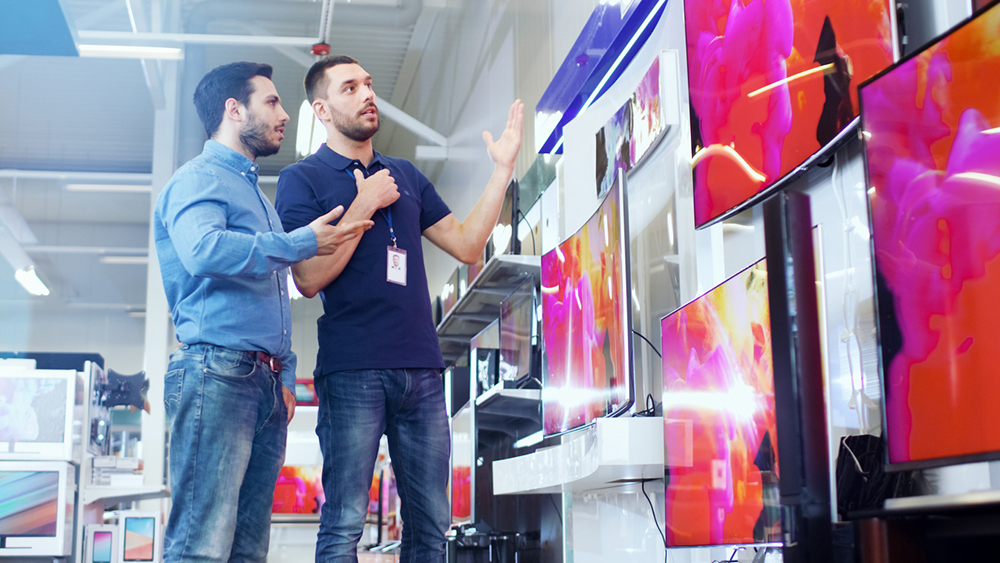

3,749 people…
…and 149 vendors descended on the Gaylord Palms Convention Center in Orlando for Nationwide’s PrimeTime event this past August.


$5,045…
…is the current price for shipping a container from China to the West Coast of the United States. This number is signicantly down from pandemic highs, which reached $18,000.


71,000 merchants…
…were added by the eCommerce platform Shopify in the first half of 2022. These numbers are a far cry from 2020 and 2021 when the online shopping platform added 680,000 and 314,000 merchants respectively


DEALERSCOPE PODCAST
Welcome to the Dealerscope Podcast – Your Source for all B2B trends in Retail, Tech and Biz!
In the high-strung consumer electronics retail business, it can be hard to take a moment to step back and breathe. The Dealerscope Podcast gives CE retail leaders the chance to kick back, relax and talk shop in a casual setting.
Get Dealerscope
and Connected Design
delivered to your doorstep
or to your email.
Click on the links below to update how and where you receive your issues! Change your mailing address or request a change from print to digital, subscribe to our newsletters, or just head to our websites.
CONNECTED DESIGN
Subscribe to Print Magazine
Renew Your Subscription
Subscribe to Newsletters


OFFICES
100 S. Juniper St., 3rd Floor
Philadelphia, PA 19109
132 West 31st Street, 9th Floor
New York, NY 10001
EDITOR IN CHIEF
Erinn Loucks
eloucks@ctlab.media
SENIOR MANAGING EDITOR
Sam Hitt
samhitt@ctlab.media
CHIEF SOCIAL MEDIA AND WEB EDITOR
Brenda Thelusca
bthelusca@ctlab.media
ASSOCIATE EDITOR
Alec Paige
apaige@ctlab.media
CONTRIBUTORS
Nancy Klosek
Brittany Mier Y Terán
John R. Quain
Jeff Unterreiner
CREATIVE
Astrid von Krenski
avkrenski@ctlab.media
GROUP PUBLISHER
Tony Monteleone
(718) 216-2046
tmonteleone@ctlab.media
OPERATIONS MANAGER
Vicki Manucci
vmanucci@ctlab.media
CIRCULATION & DISTRIBUTION
Carrianne Ramsey
cramsey@ctlab.media
ACCOUNTING/HR MANAGER
Catalina Gonzalez
cgonzalez@ctlab.media
CHIEF OPERATING OFFICER
Alice Schmalzl
(484) 645-1691
aschmalzl@ctlab.media
OFFICES
100 S. Juniper St., 3rd Floor
Philadelphia, PA 19109
132 West 31st Street, 9th Floor
New York, NY 10001
dealerscope.com
Publisher of Dealerscope, and Connected Design
Copyright ©2022 CT Lab Global Media LLC
CT Lab Global Media is a diversified publisher of business and professional magazines. This publication is provided with the express understanding and agreement that the information and data within it will be solely for internal use and will not be used for the creation or updating of mailing lists for sale or distribution to third parties. Printed in the U.S.A.


